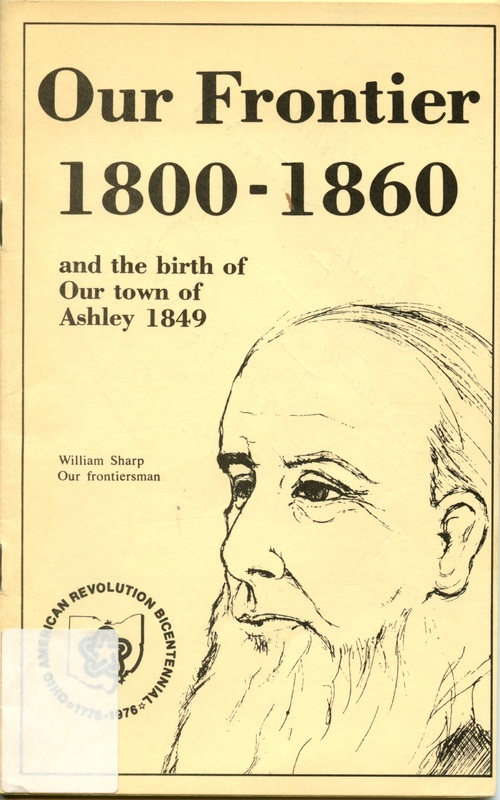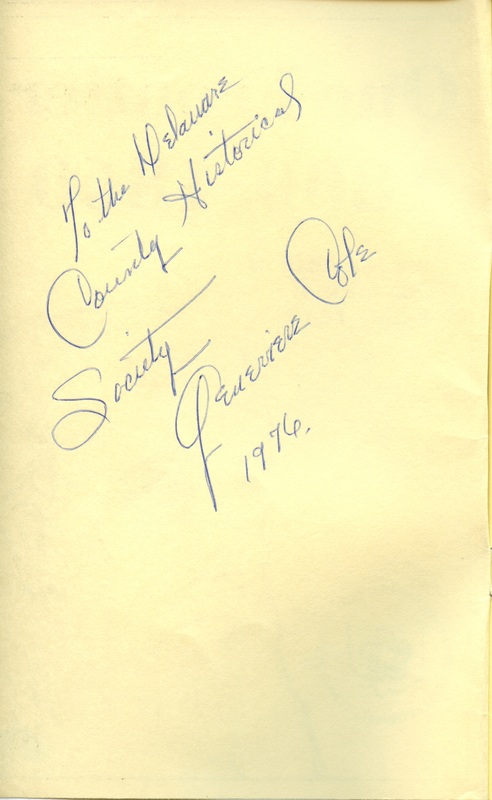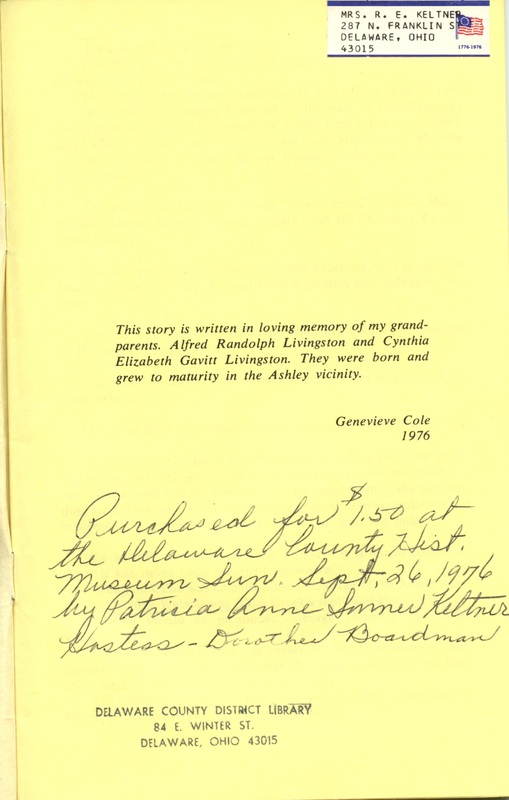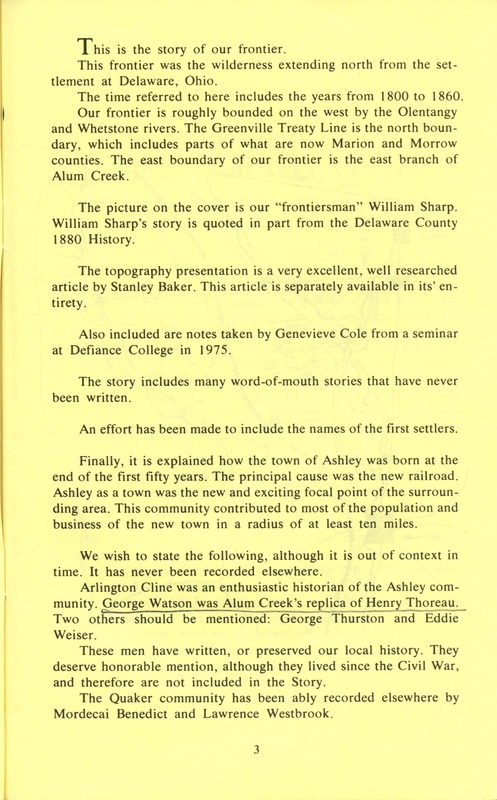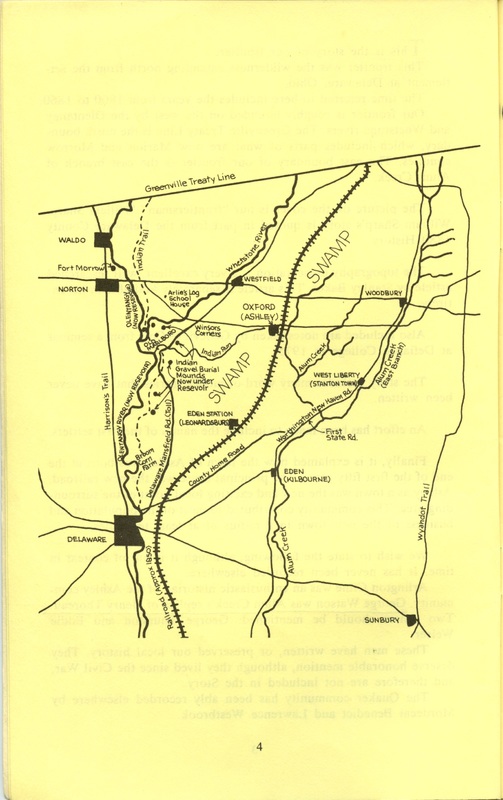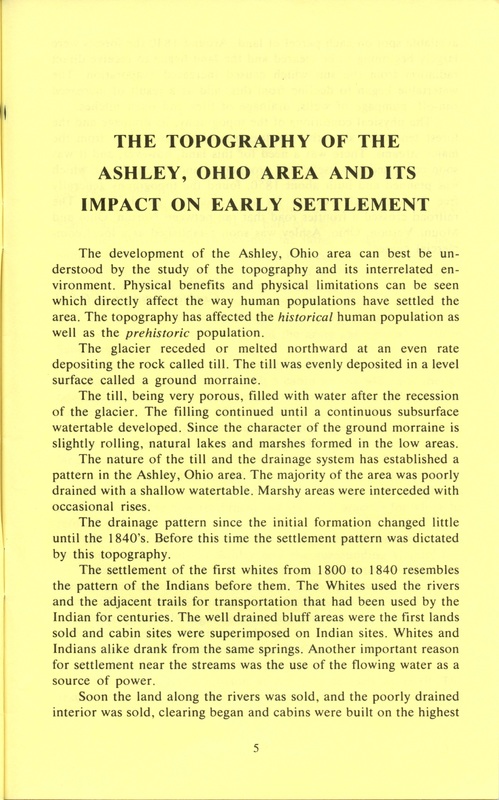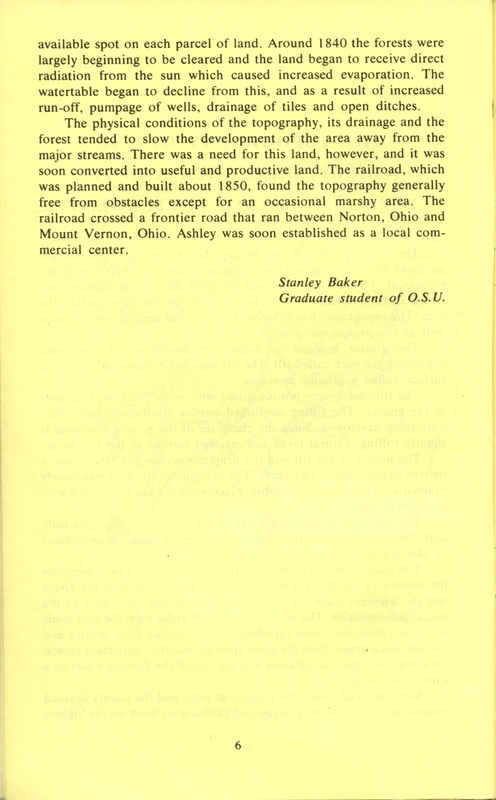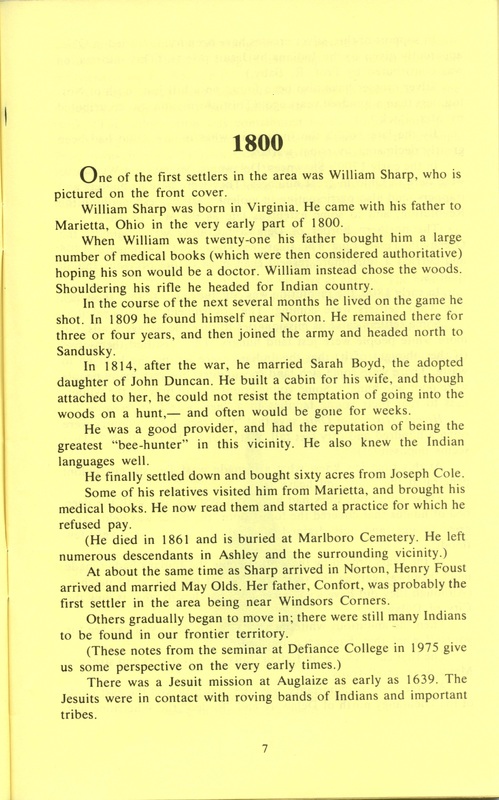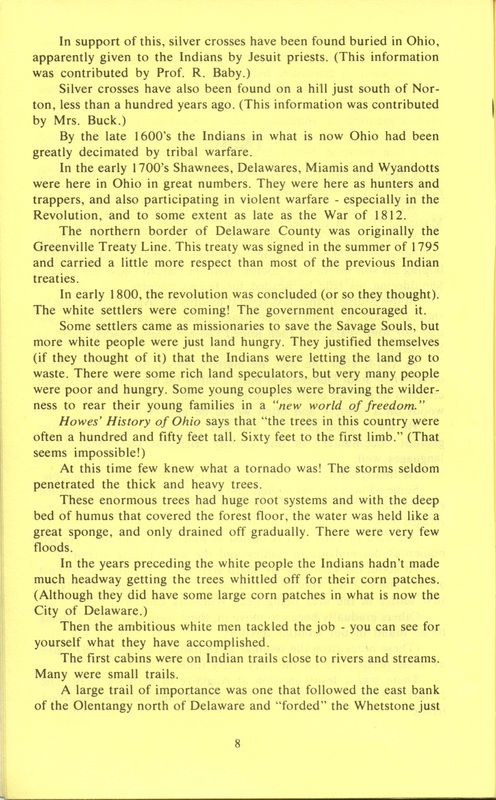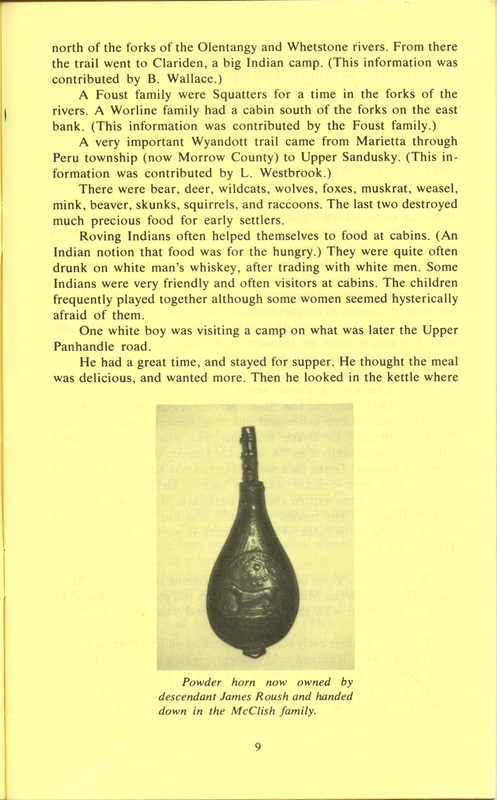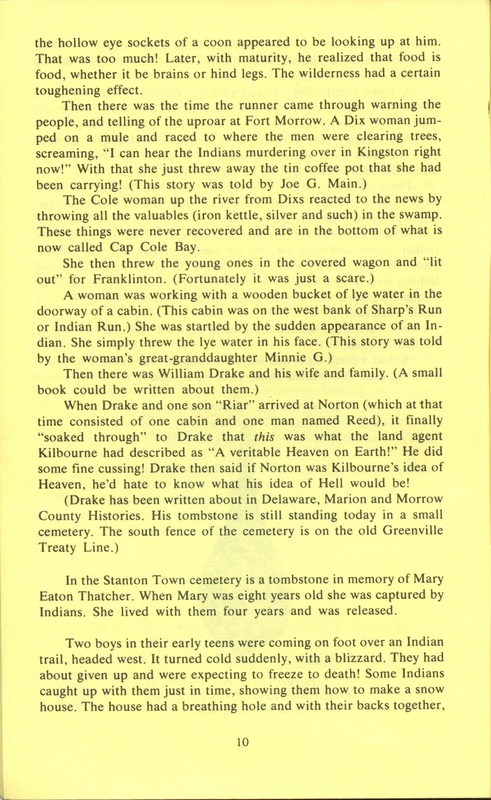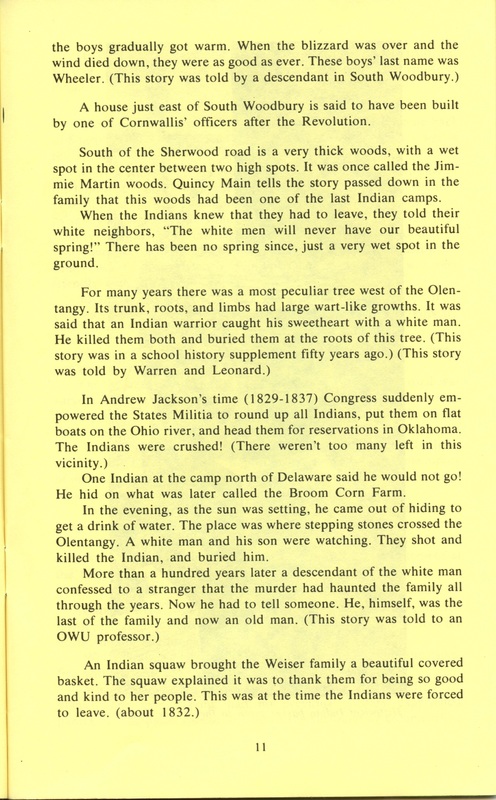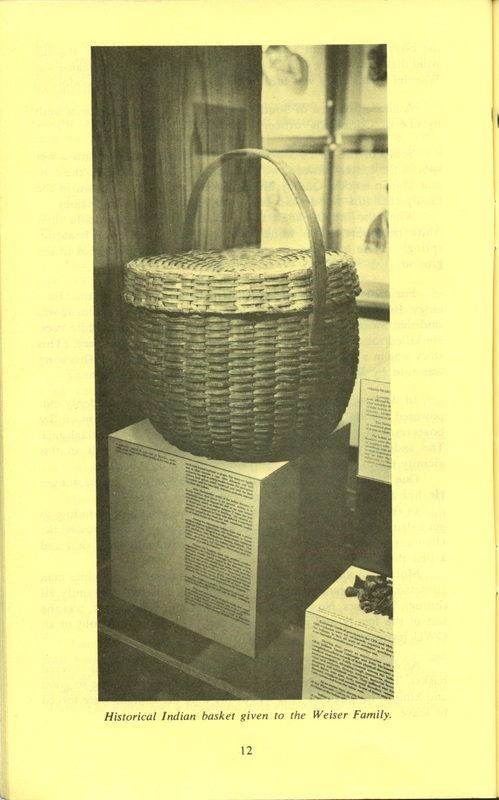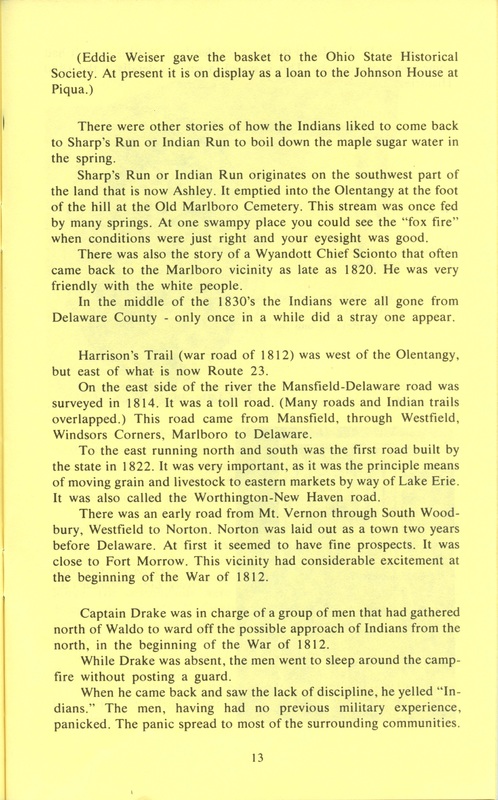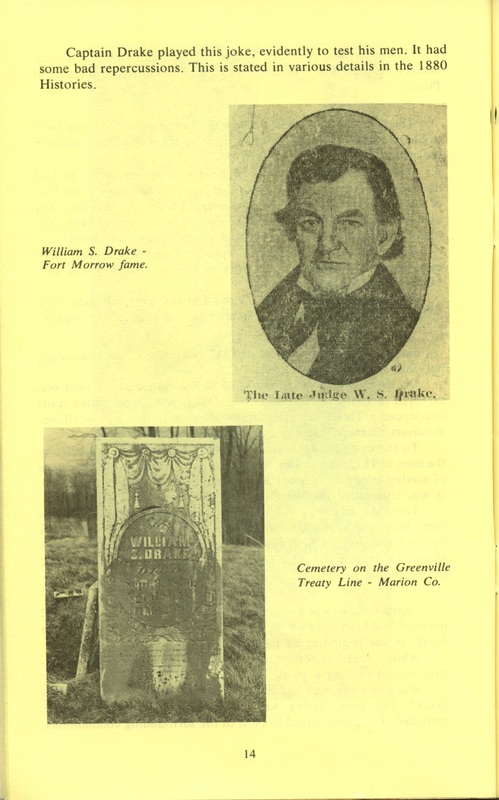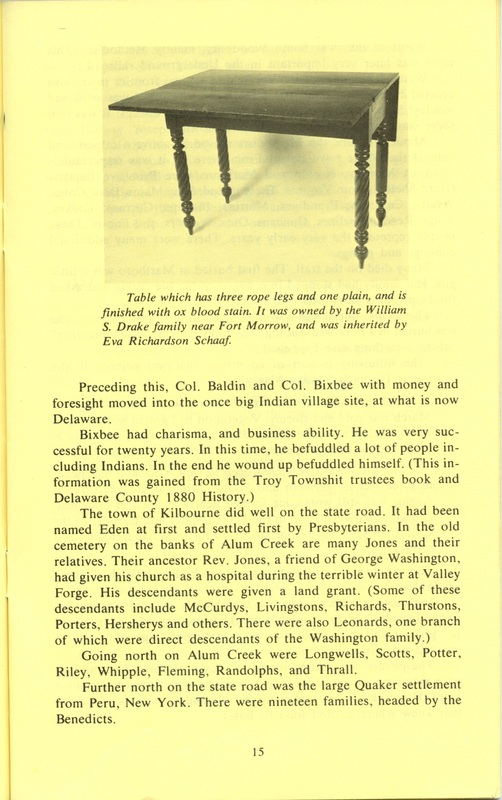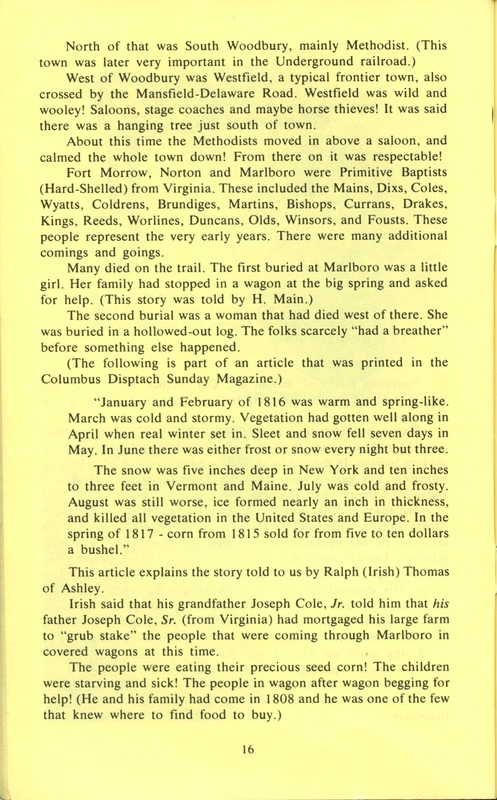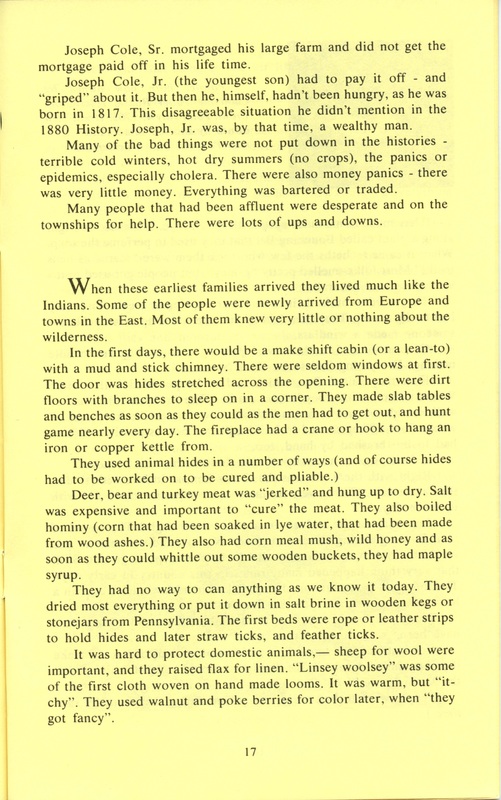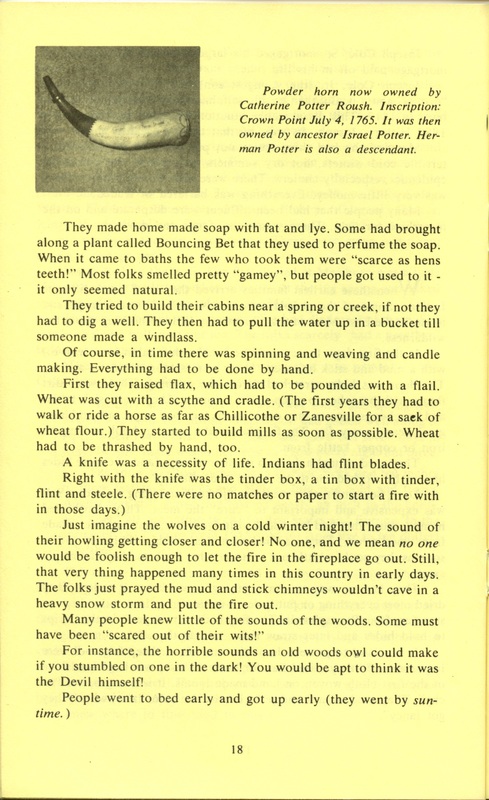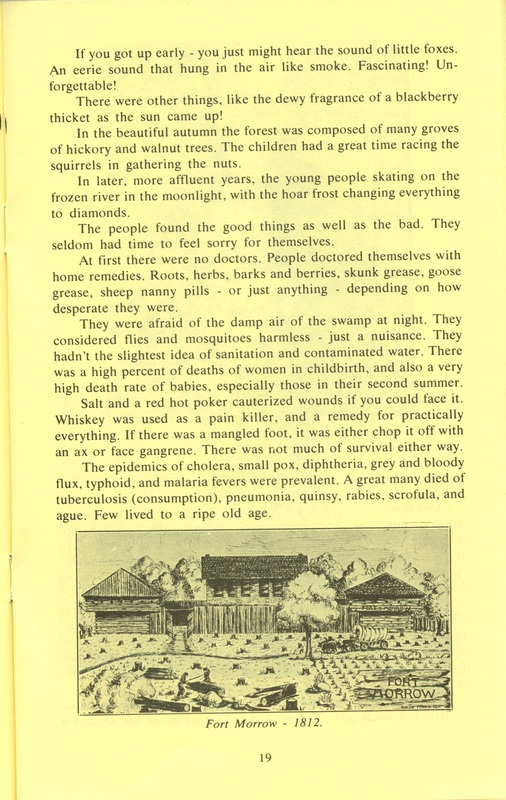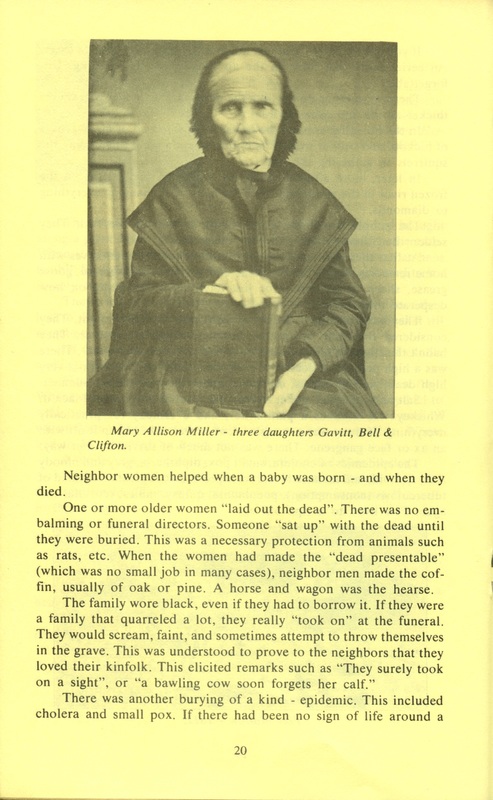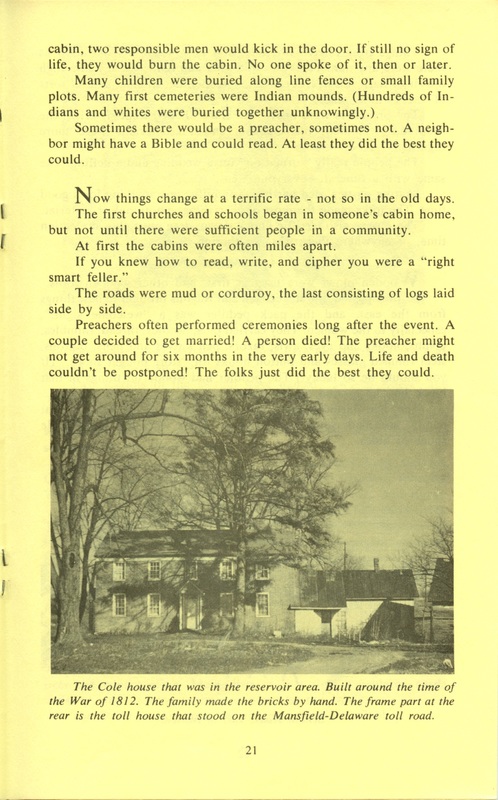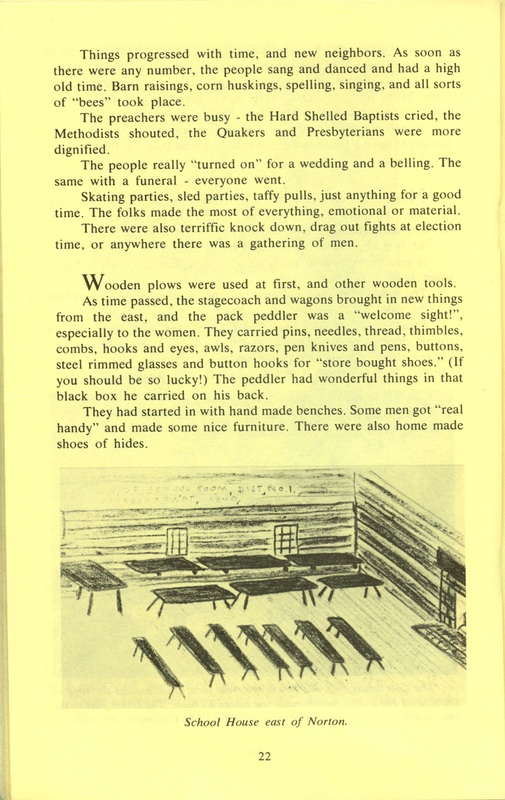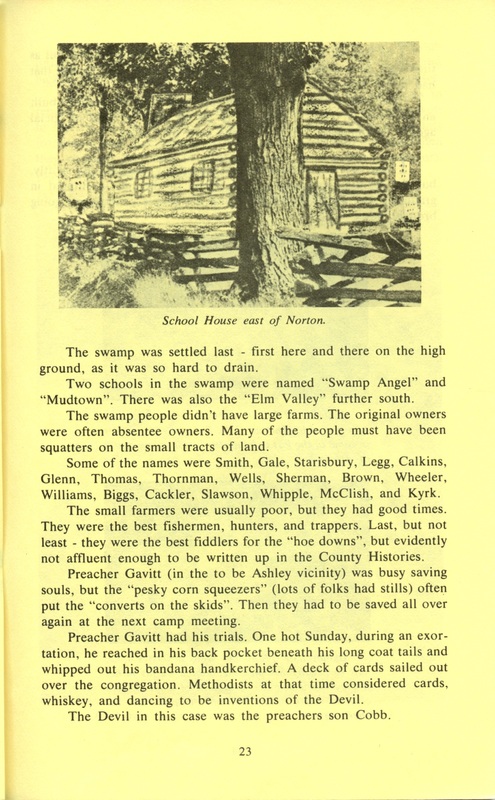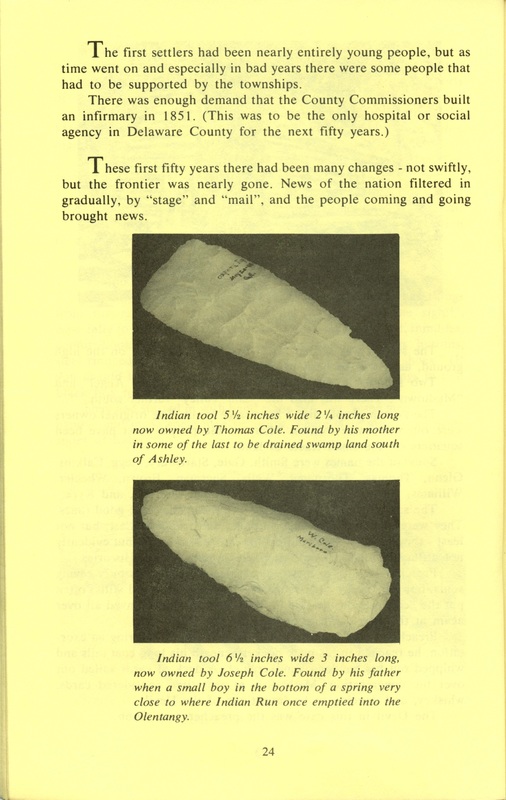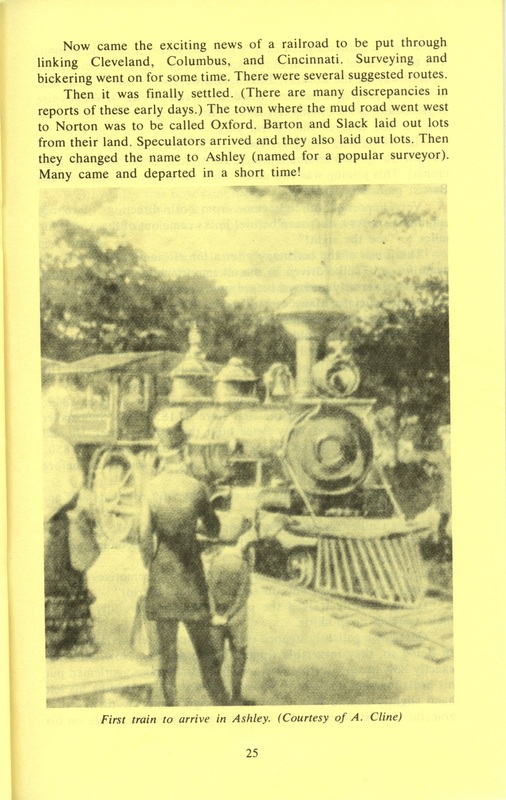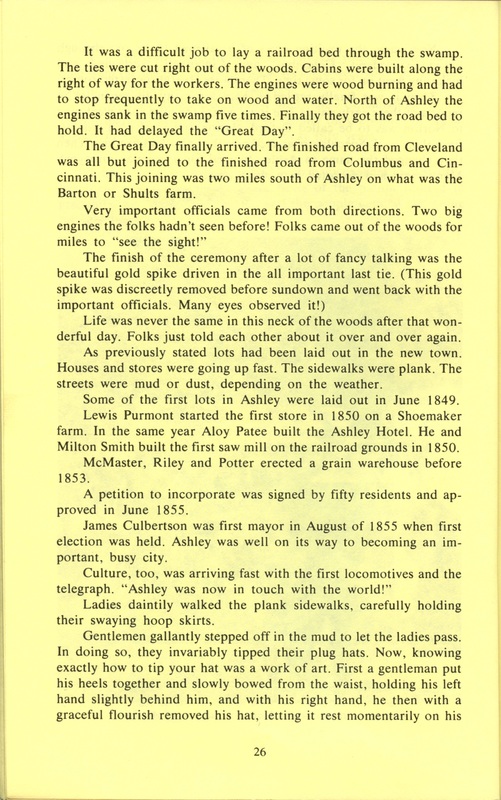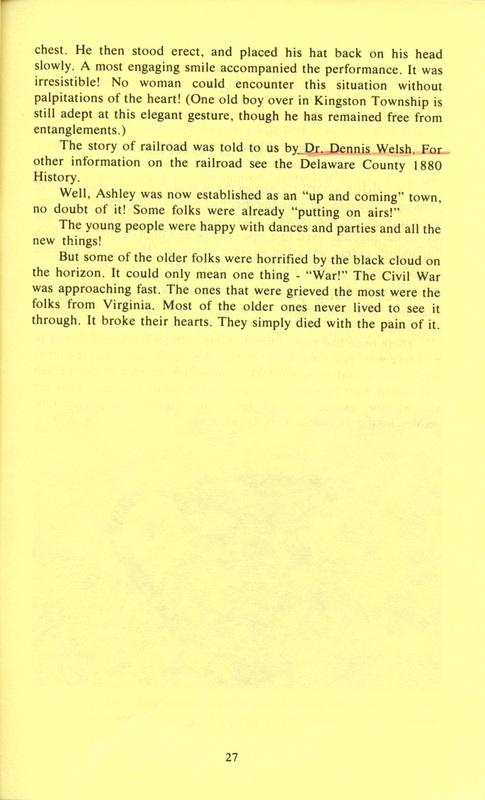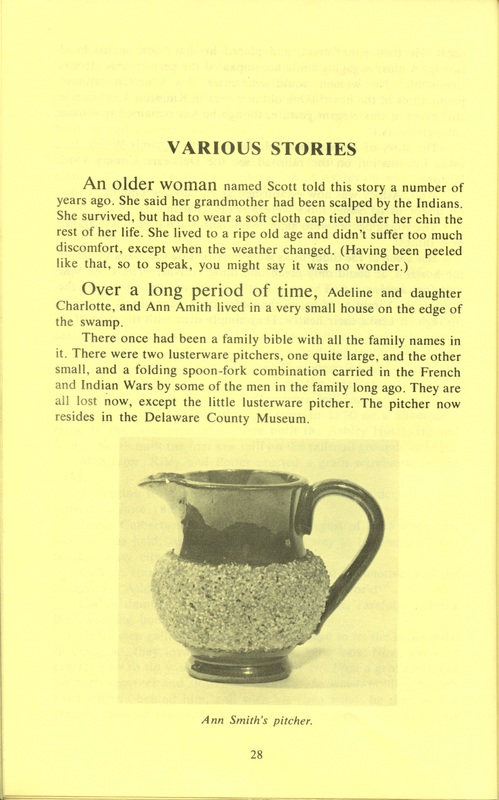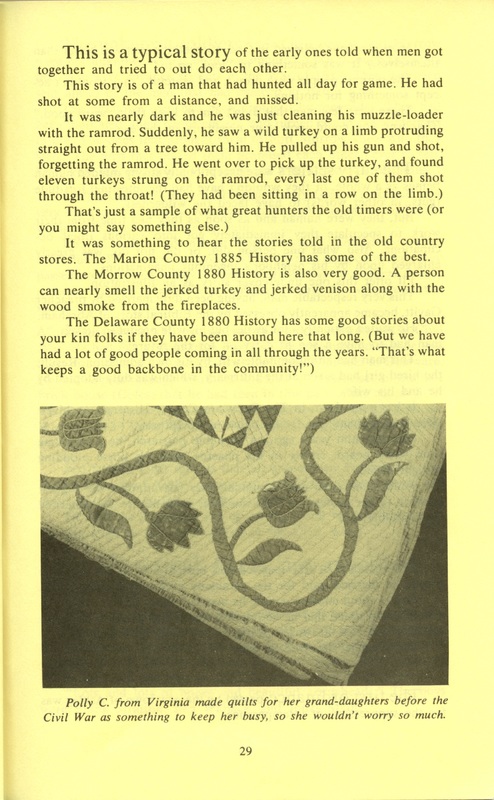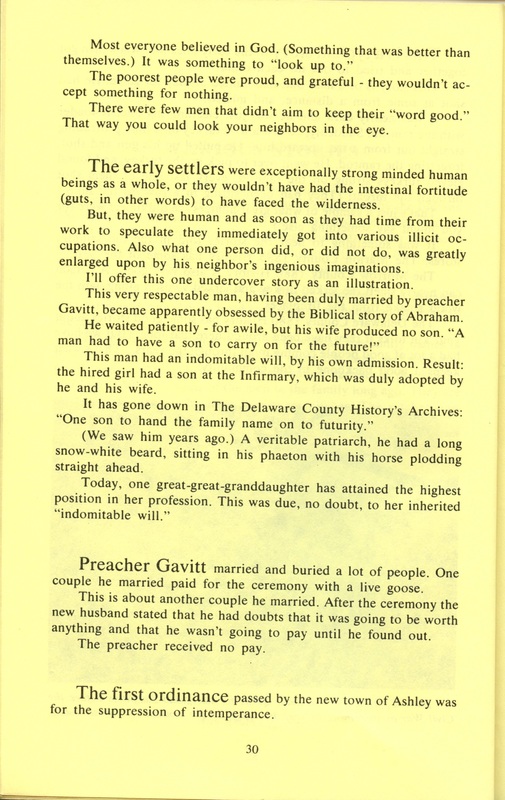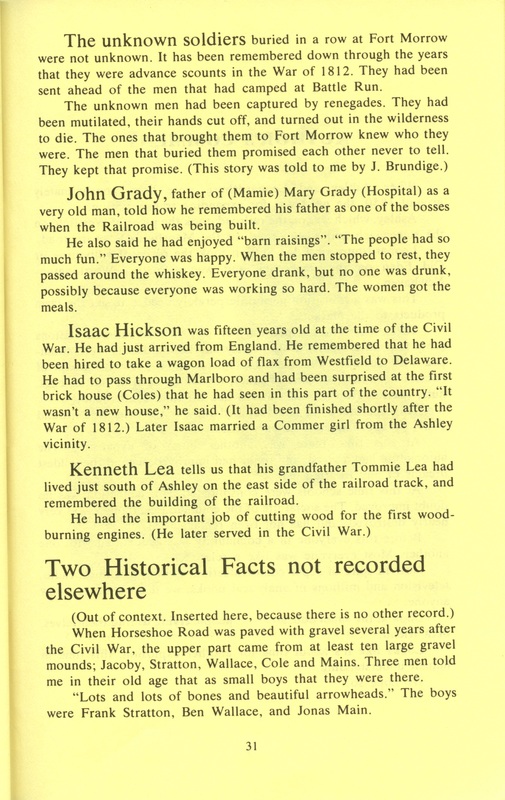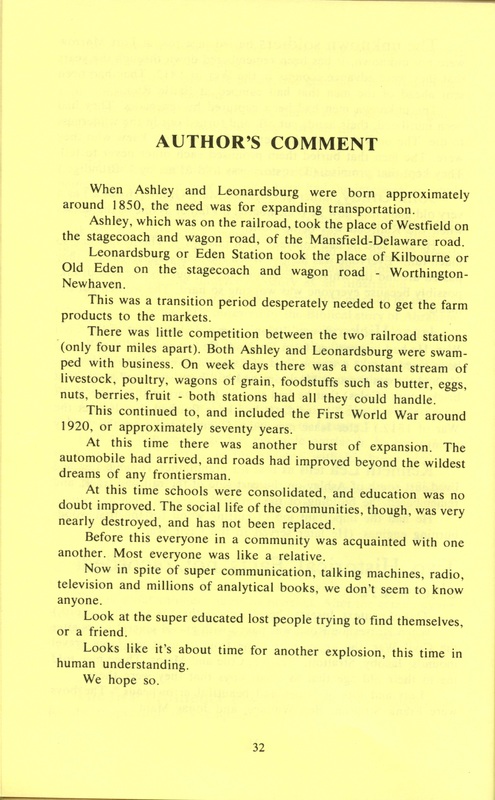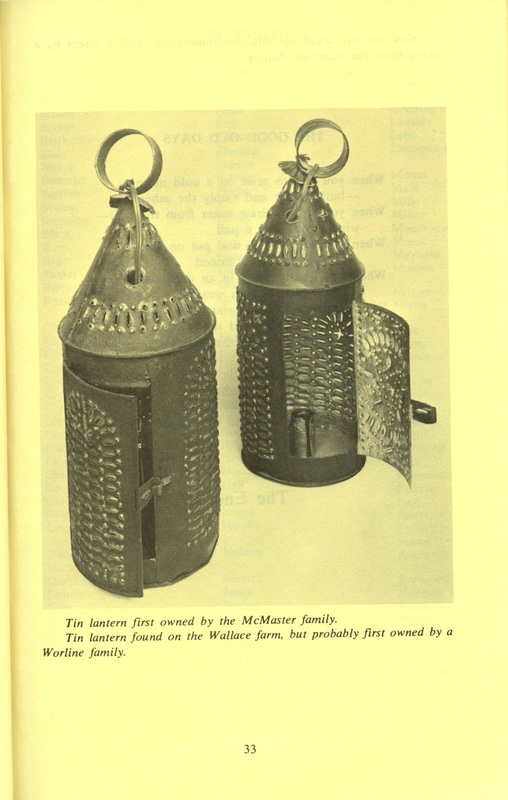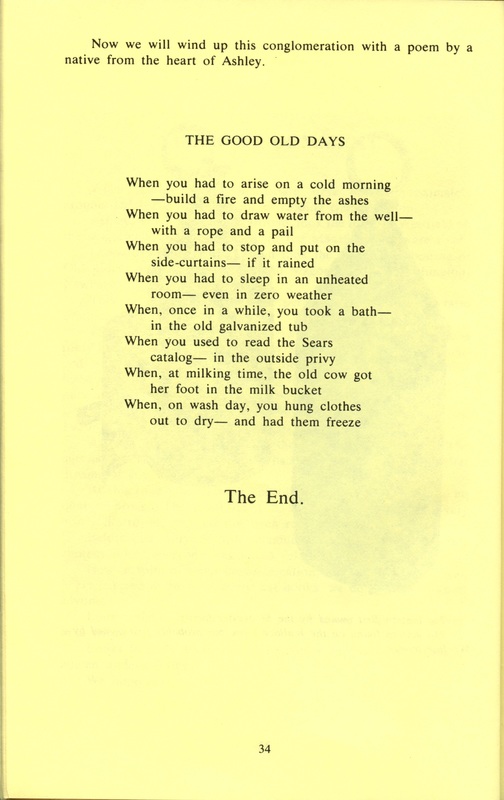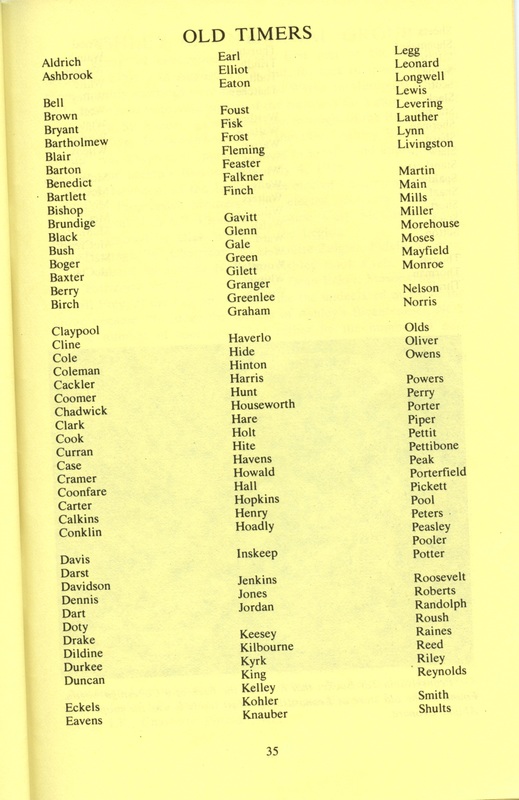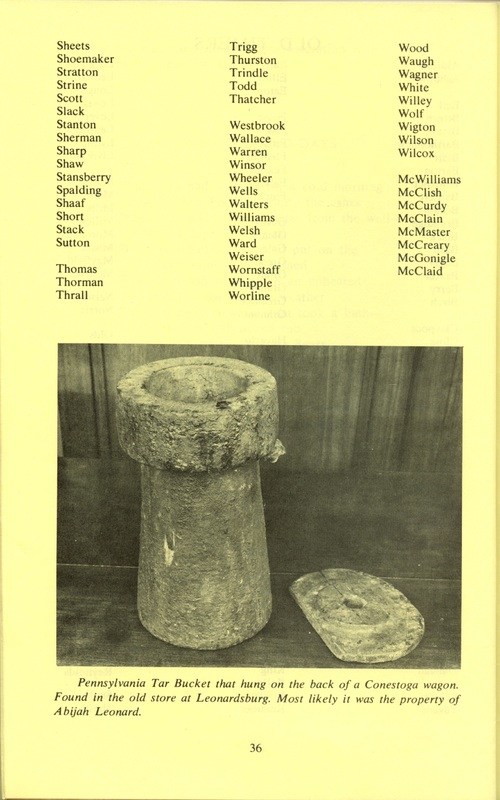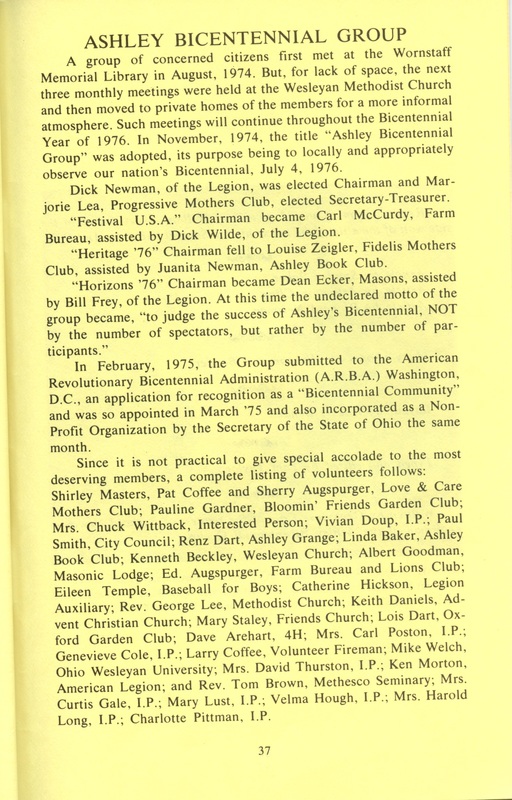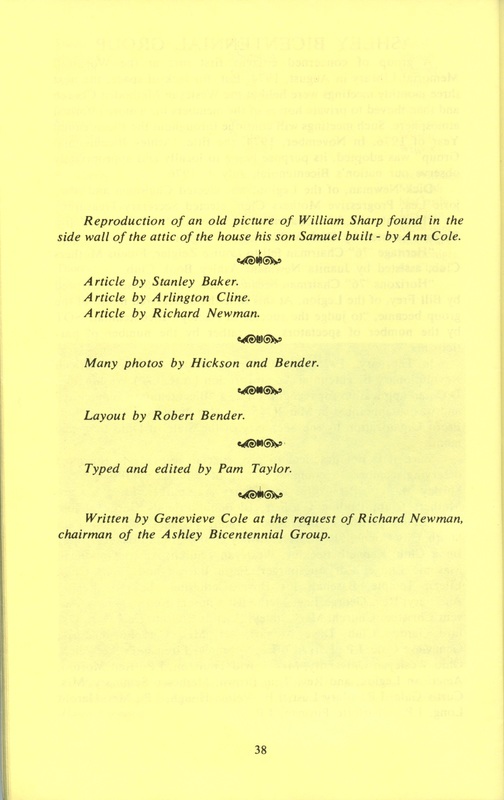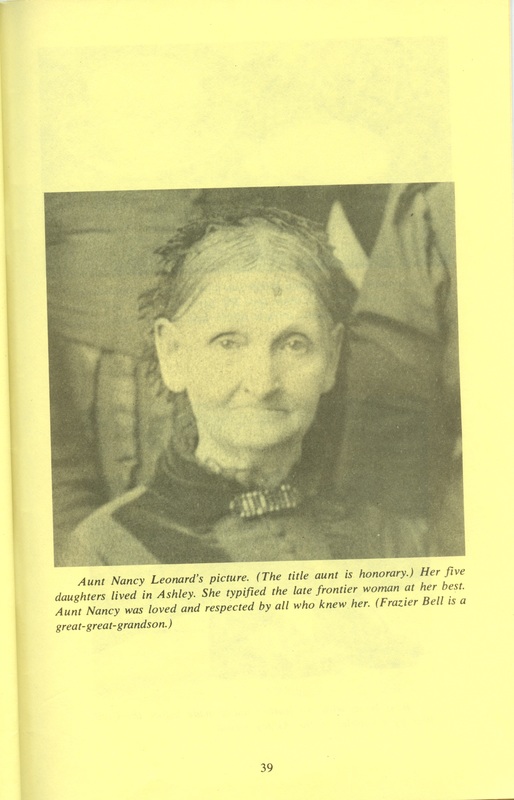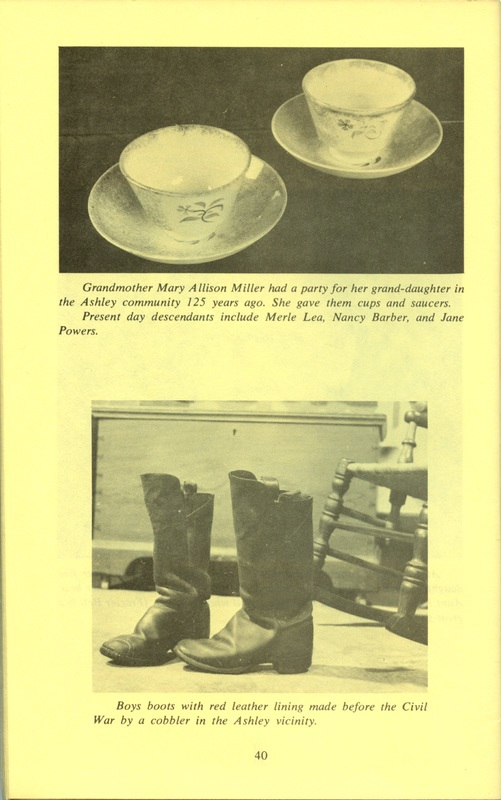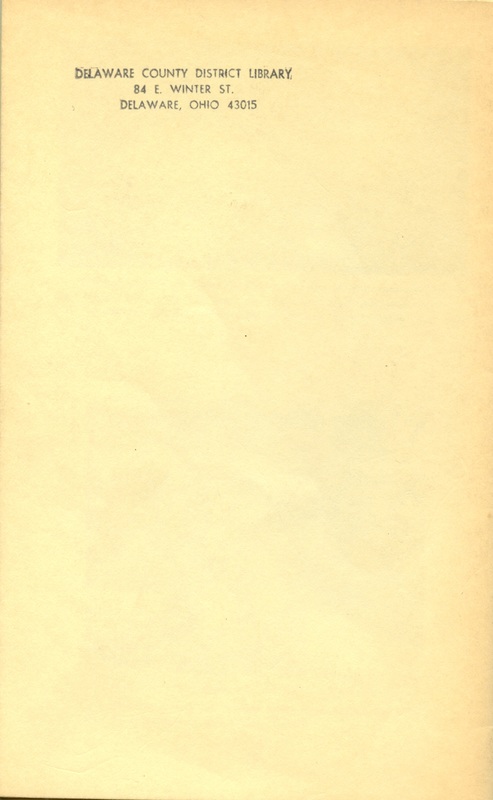Our Frontier 1800-1860 and the Birth of Our Town of Ashley 1849
Title
Our Frontier 1800-1860 and the Birth of Our Town of Ashley 1849 (p. 1)
Description
[page 1]
[corresponds to front cover of Our Frontier 1800-1860]
Our Frontier
1800-1860
and the birth of
Our town of
Ashley 1849
William Sharp
Our frontiersman
[image of Sharp]
OHIO AMERICAN REVOLUTION BICENTENNIAL 1776-1976
[corresponds to front cover of Our Frontier 1800-1860]
Our Frontier
1800-1860
and the birth of
Our town of
Ashley 1849
William Sharp
Our frontiersman
[image of Sharp]
OHIO AMERICAN REVOLUTION BICENTENNIAL 1776-1976
Creator
William Sharp
Rights
http://rightsstatements.org/vocab/NoC-US/1.0/
Format
Book
Language
English
Type
Still Image
Text
Text
Title
Our Frontier 1800-1860 and the Birth of Our Town of Ashley 1849 (p. 2)
Description
[page 2]
[corresponds to unlabeled page 2 of Our Frontier 1800-1860]
[signed by the author]
[corresponds to unlabeled page 2 of Our Frontier 1800-1860]
[signed by the author]
Title
Our Frontier 1800-1860 and the Birth of Our Town of Ashley 1849 (p. 3)
Description
[page 3]
[corresponds to unlabeled page 3 of Our Frontier 1800-1860]
This story is written in loving memory of my grand-
parents. Alfred Randolph Livingston and Cynthia
Elizabeth Gavitt Livingston. They were born and
grew to maturity in the Ashley vicinity.
Genevieve Cole
1976
[corresponds to unlabeled page 3 of Our Frontier 1800-1860]
This story is written in loving memory of my grand-
parents. Alfred Randolph Livingston and Cynthia
Elizabeth Gavitt Livingston. They were born and
grew to maturity in the Ashley vicinity.
Genevieve Cole
1976
Title
Our Frontier 1800-1860 and the Birth of Our Town of Ashley 1849 (p. 4)
Description
[page 4]
[corresponds to page 3 of Our Frontier 1800-1860]
This is the story of our frontier.
This frontier was the wilderness extending north from the set-
tlement at Delaware, Ohio.
The time referred to here includes the years from 1800 to 1860.
Our frontier is roughly bounded on the west by the Olentangy
and Whetstone rivers. The Greenville Treaty Line is the north boun-
dary, which includes parts of what are now Marion and Morrow
counties. The east boundary of our frontier is the east branch of
Alum Creek.
The picture on the cover is our "frontiersman" William Sharp.
William Sharp's story is quoted in part from the Delaware County
1880 History.
The topography presentation is a very excellent, well researched
article by Stanley Baker. This article is separately available in its' en-
tirety.
Also included are notes taken by Genevieve Cole from a seminar
at Defiance College in 1975.
The story includes many word-of-mouth stories that have never
been written.
An effort has been made to include the names of the first settlers.
Finally, it is explained how the town of Ashley was born at the
end of the first fifty years. The principal cause was the new railroad.
Ashley as a town was the new and exciting focal point of the surroun-
ding area. This community contributed to most of the population and
business of the new town in a radius of at least ten miles.
We wish to state the following, although it is out of context in
time. It has never been recorded elsewhere.
Arlington Cline was an enthusiastic historian of the Ashley com-
munity. George Watson was Alum Creek's replica of Henry Thoreau.
Two others should be mentioned: George Thurston and Eddie
Weiser.
These men have written, or preserved our local history. They
deserve honorable mention, although they lived since the Civil War,
and therefore are not included in the Story.
The Quaker community has been ably recorded elsewhere by
Mordecai Benedict and Lawrence Westbrook.
3
[corresponds to page 3 of Our Frontier 1800-1860]
This is the story of our frontier.
This frontier was the wilderness extending north from the set-
tlement at Delaware, Ohio.
The time referred to here includes the years from 1800 to 1860.
Our frontier is roughly bounded on the west by the Olentangy
and Whetstone rivers. The Greenville Treaty Line is the north boun-
dary, which includes parts of what are now Marion and Morrow
counties. The east boundary of our frontier is the east branch of
Alum Creek.
The picture on the cover is our "frontiersman" William Sharp.
William Sharp's story is quoted in part from the Delaware County
1880 History.
The topography presentation is a very excellent, well researched
article by Stanley Baker. This article is separately available in its' en-
tirety.
Also included are notes taken by Genevieve Cole from a seminar
at Defiance College in 1975.
The story includes many word-of-mouth stories that have never
been written.
An effort has been made to include the names of the first settlers.
Finally, it is explained how the town of Ashley was born at the
end of the first fifty years. The principal cause was the new railroad.
Ashley as a town was the new and exciting focal point of the surroun-
ding area. This community contributed to most of the population and
business of the new town in a radius of at least ten miles.
We wish to state the following, although it is out of context in
time. It has never been recorded elsewhere.
Arlington Cline was an enthusiastic historian of the Ashley com-
munity. George Watson was Alum Creek's replica of Henry Thoreau.
Two others should be mentioned: George Thurston and Eddie
Weiser.
These men have written, or preserved our local history. They
deserve honorable mention, although they lived since the Civil War,
and therefore are not included in the Story.
The Quaker community has been ably recorded elsewhere by
Mordecai Benedict and Lawrence Westbrook.
3
Title
Our Frontier 1800-1860 and the Birth of Our Town of Ashley 1849 (p. 5)
Description
[page 5]
[corresponds to page 4 of Our Frontier 1800-1860]
[map of Ashley/Delaware County]
4
[corresponds to page 4 of Our Frontier 1800-1860]
[map of Ashley/Delaware County]
4
Title
Our Frontier 1800-1860 and the Birth of Our Town of Ashley 1849 (p. 6)
Description
[page 6]
[corresponds to page 5 of Our Frontier 1800-1860]
THE TOPOGRAPHY OF THE
ASHLEY, OHIO AREA AND ITS
IMPACT ON EARLY SETTLEMENT
The development of the Ashley, Ohio area can best be un-
derstood by the study of the topography and its interrelated en-
vironment. Physical benefits and physical limitations can be seen
which directly affect the way human populations have settled the
area. The topography has affected the historical human population as
well as the prehistoric population.
The glacier receded or melted northward at an even rate
depositing the rock called till. The till was evenly deposited in a level
surface called a ground morraine.
The till, being very porous, filled with water after the recession
of the glacier. The filling continued until a continuous subsurface
watertable developed. Since the character of the ground morraine is
slightly rolling, natural lakes and marshes formed in the low areas.
The nature of the till and drainage system has established a
pattern in the Ashley, Ohio area. The majority of the area was poorly
drained with a shallow watertable. Marshy areas were interceded with
occasional rises.
The drainage pattern since the initial formation changed little
until the 1840's. Before this time the settlement pattern was dictated
by this topography.
The settlement of the first whites from 1800 to 1840 resembles
the pattern of the Indians before them. The Whites used the rivers
and the adjacent trails for transportation that had been used by the
Indian for centuries. The well drained bluff areas were the first lands
sold and cabin sites were superimposed on Indian sites. Whites and
Indians alike drank from the same springs. Another important reason
for settlement near the streams was the use of the flowing water as a
source of power.
Soon the land along the rivers was sold, and the poorly drained
interior was sold, clearing began and cabins were built on the highest
5
[corresponds to page 5 of Our Frontier 1800-1860]
THE TOPOGRAPHY OF THE
ASHLEY, OHIO AREA AND ITS
IMPACT ON EARLY SETTLEMENT
The development of the Ashley, Ohio area can best be un-
derstood by the study of the topography and its interrelated en-
vironment. Physical benefits and physical limitations can be seen
which directly affect the way human populations have settled the
area. The topography has affected the historical human population as
well as the prehistoric population.
The glacier receded or melted northward at an even rate
depositing the rock called till. The till was evenly deposited in a level
surface called a ground morraine.
The till, being very porous, filled with water after the recession
of the glacier. The filling continued until a continuous subsurface
watertable developed. Since the character of the ground morraine is
slightly rolling, natural lakes and marshes formed in the low areas.
The nature of the till and drainage system has established a
pattern in the Ashley, Ohio area. The majority of the area was poorly
drained with a shallow watertable. Marshy areas were interceded with
occasional rises.
The drainage pattern since the initial formation changed little
until the 1840's. Before this time the settlement pattern was dictated
by this topography.
The settlement of the first whites from 1800 to 1840 resembles
the pattern of the Indians before them. The Whites used the rivers
and the adjacent trails for transportation that had been used by the
Indian for centuries. The well drained bluff areas were the first lands
sold and cabin sites were superimposed on Indian sites. Whites and
Indians alike drank from the same springs. Another important reason
for settlement near the streams was the use of the flowing water as a
source of power.
Soon the land along the rivers was sold, and the poorly drained
interior was sold, clearing began and cabins were built on the highest
5
Title
Our Frontier 1800-1860 and the Birth of Our Town of Ashley 1849 (p. 7)
Description
[page 7]
[corresponds to page 6 of Our Frontier 1800-1860]
available spot on each parcel of land. Around 1840 the forests were
largely beginning to be cleared and the land began to receive direct
radiation from the sun which caused increased evaporation. The
watertable began to decline from this, and as a result of increased
run-off, pumpage of wells, drainage of tiles and open ditches.
The physical conditions of the topography, its drainage and the
forest tended to slow the development of the area away from the
major streams. There was a need for this land, however, and it was
soon converted into useful and productive land. The railroad, which
was planned and built about 1850, found the topography generally
free from obstacles except for an occasional marshy area. The
railroad crossed a frontier road that ran between Norton, Ohio and
Mount Vernon, Ohio. Ashley was soon established as a local com-
mercial center.
Stanley Baker
Graduate student of O.S.U.
6
[corresponds to page 6 of Our Frontier 1800-1860]
available spot on each parcel of land. Around 1840 the forests were
largely beginning to be cleared and the land began to receive direct
radiation from the sun which caused increased evaporation. The
watertable began to decline from this, and as a result of increased
run-off, pumpage of wells, drainage of tiles and open ditches.
The physical conditions of the topography, its drainage and the
forest tended to slow the development of the area away from the
major streams. There was a need for this land, however, and it was
soon converted into useful and productive land. The railroad, which
was planned and built about 1850, found the topography generally
free from obstacles except for an occasional marshy area. The
railroad crossed a frontier road that ran between Norton, Ohio and
Mount Vernon, Ohio. Ashley was soon established as a local com-
mercial center.
Stanley Baker
Graduate student of O.S.U.
6
Title
Our Frontier 1800-1860 and the Birth of Our Town of Ashley 1849 (p. 8)
Description
[page 8]
[corresponds to page 7 of Our Frontier 1800-1860]
1800
One of the first settlers in the area was William Sharp, who is
pictured on the front cover.
William Sharp was born in Virginia. He came with his father to
Marietta, Ohio in the very early part of 1800.
When William was twenty-one his father bought him a large
number of medical books (which were then considered authoritative)
hoping his son would be a doctor. William instead chose the woods.
Shouldering his rifle he headed for Indian country.
In the course of the next several months he lived on the game he
shot. In 1809 he found himself near Norton. He remained there for
three or four years, and then joined the army and headed north to
Sandusky.
In 1814, after the war, he married Sarah Boyd, the adopted
daughter of John Duncan. He built a cabin for his wife, and though
attached to her, he could not resist the temptation of going into the
woods on a hunt,-- and often would be gone for weeks.
He was a good provider, and had the reputation of being the
greatest "bee-hunter" in the vicinity. He also knew the Indian
languages well.
He finally settled down and bought sixy acres from Joseph Cole.
Some of his relatives visited him from Marietta, and brought his
medical books. He now read them and started a practice for which he
refused pay.
(He died in 1861 and is buried in Marlboro Cemetery. He left
numerous descendants in Ashley and the surrounding vicinity.)
At about the same time as Sharp arrived in Norton, Henry Foust
arrived and married May Olds. Her father, Confort, was probably the
first settler in the area being near Windsors Corners.
Others gradually began to move in; there were still many Indians
to be found in our frontier territory.
(These notes from the seminar at Defiance College in 1975 give
us some perspective on the very early times.)
There was a Jesuit mission at Auglaize as early as 1639. The
Jesuits were in contact with roving bands of Indians and important
tribes.
7
[corresponds to page 7 of Our Frontier 1800-1860]
1800
One of the first settlers in the area was William Sharp, who is
pictured on the front cover.
William Sharp was born in Virginia. He came with his father to
Marietta, Ohio in the very early part of 1800.
When William was twenty-one his father bought him a large
number of medical books (which were then considered authoritative)
hoping his son would be a doctor. William instead chose the woods.
Shouldering his rifle he headed for Indian country.
In the course of the next several months he lived on the game he
shot. In 1809 he found himself near Norton. He remained there for
three or four years, and then joined the army and headed north to
Sandusky.
In 1814, after the war, he married Sarah Boyd, the adopted
daughter of John Duncan. He built a cabin for his wife, and though
attached to her, he could not resist the temptation of going into the
woods on a hunt,-- and often would be gone for weeks.
He was a good provider, and had the reputation of being the
greatest "bee-hunter" in the vicinity. He also knew the Indian
languages well.
He finally settled down and bought sixy acres from Joseph Cole.
Some of his relatives visited him from Marietta, and brought his
medical books. He now read them and started a practice for which he
refused pay.
(He died in 1861 and is buried in Marlboro Cemetery. He left
numerous descendants in Ashley and the surrounding vicinity.)
At about the same time as Sharp arrived in Norton, Henry Foust
arrived and married May Olds. Her father, Confort, was probably the
first settler in the area being near Windsors Corners.
Others gradually began to move in; there were still many Indians
to be found in our frontier territory.
(These notes from the seminar at Defiance College in 1975 give
us some perspective on the very early times.)
There was a Jesuit mission at Auglaize as early as 1639. The
Jesuits were in contact with roving bands of Indians and important
tribes.
7
Title
Our Frontier 1800-1860 and the Birth of Our Town of Ashley 1849 (p. 9)
Description
[page 9]
[corresponds to page 8 of Our Frontier 1800-1860]
In support of this, silver crosses have been found buried in Ohio,
apparently given to the Indians by Jesuit priests. (This information
was contributed by Prof. R. Baby.)
Silver crosses have also been found on a hill just south of Nor-
ton, less than a hundred years ago. (This information was contributed
by Mrs. Buck.)
By the late 1600's the Indians in what is now Ohio had been
greatly decimated by tribal warfare.
In the early 1700's Shawnees, Delawares, Miamis and Wyandotts
were here in Ohio in great numbers. They were here as hunters and
trappers, and also participating in violent warfare - especially in the
Revolution, and to some extent as late as the War of 1812.
The northern border of Delaware County was originally the
Greenville Treaty Line. This treaty was signed in the summer of 1795
and carried a little more respect than most of the previous Indian
treaties.
In early 1800, the revolution was concluded (or so they thought).
The white settlers were coming! The government encouraged it.
Some settlers came as missionaries to save the Savage Souls, but
more white people were just land hungry. They justified themselves
(if they thought of it) that the Indians were letting the land go to
waste. There were some rich land speculators, but very many people
were poor and hungry. Some young couples were braving the wilder-
ness to rear their young families in a "new world of freedom."
Howes' History of Ohio says that "the trees in this country were
often a hundred and fifty feet tall. Sixty feet to the first limb." (That
seems impossible!)
At this time few knew what a tornado was! The storms seldom
penetrated the thick and heavy trees.
These enormous trees has huge root systems and with the deep
bed of humus that covered the forest floor, the water was held like a
great sponge, and only drained off gradually. There were very few
floods.
In the years preceding the white people the Indians hadn't made
much headway getting the trees whittled off for their corn patches.
(Although they did have some large corn patches in what is now the
City of Delaware.)
Then the ambitious white men tackled the job - you can see for
yourself what they have accomplished.
The first cabins were on Indian trails close to rivers and streams.
Many were small trails.
A large trail of importance was one that followed the east bank
of the Olentangy north of Delaware and "forded" the Whetstone just
8
[corresponds to page 8 of Our Frontier 1800-1860]
In support of this, silver crosses have been found buried in Ohio,
apparently given to the Indians by Jesuit priests. (This information
was contributed by Prof. R. Baby.)
Silver crosses have also been found on a hill just south of Nor-
ton, less than a hundred years ago. (This information was contributed
by Mrs. Buck.)
By the late 1600's the Indians in what is now Ohio had been
greatly decimated by tribal warfare.
In the early 1700's Shawnees, Delawares, Miamis and Wyandotts
were here in Ohio in great numbers. They were here as hunters and
trappers, and also participating in violent warfare - especially in the
Revolution, and to some extent as late as the War of 1812.
The northern border of Delaware County was originally the
Greenville Treaty Line. This treaty was signed in the summer of 1795
and carried a little more respect than most of the previous Indian
treaties.
In early 1800, the revolution was concluded (or so they thought).
The white settlers were coming! The government encouraged it.
Some settlers came as missionaries to save the Savage Souls, but
more white people were just land hungry. They justified themselves
(if they thought of it) that the Indians were letting the land go to
waste. There were some rich land speculators, but very many people
were poor and hungry. Some young couples were braving the wilder-
ness to rear their young families in a "new world of freedom."
Howes' History of Ohio says that "the trees in this country were
often a hundred and fifty feet tall. Sixty feet to the first limb." (That
seems impossible!)
At this time few knew what a tornado was! The storms seldom
penetrated the thick and heavy trees.
These enormous trees has huge root systems and with the deep
bed of humus that covered the forest floor, the water was held like a
great sponge, and only drained off gradually. There were very few
floods.
In the years preceding the white people the Indians hadn't made
much headway getting the trees whittled off for their corn patches.
(Although they did have some large corn patches in what is now the
City of Delaware.)
Then the ambitious white men tackled the job - you can see for
yourself what they have accomplished.
The first cabins were on Indian trails close to rivers and streams.
Many were small trails.
A large trail of importance was one that followed the east bank
of the Olentangy north of Delaware and "forded" the Whetstone just
8
Title
Our Frontier 1800-1860 and the Birth of Our Town of Ashley 1849 (p. 10)
Description
[page 10]
[corresponds to page 9 of Our Frontier 1800-1860]
north of the forks of the Olentangy and Whetstone rivers. From there
the trail went to Clariden, a big Indian camp. (This information was
contributed by B. Wallace.)
A Foust family were Squatters for a time in the forks of the
rivers. A Worline family had a cabin south of the forks on the east
bank. (This information was contributed by the Foust family.)
A very important Wyandott trail came to Marietta through
Peru township (now Morrow County) to Upper Sandusky. (This in-
formation was contributed by L. Westbrook.)
There were bear, deer, wildcats, wolves, foxes, muskrat, weasel,
milk, beaver, skunks, squirrels, and raccoons. The last two destroyed
much precious food for early settlers.
Roving Indians often helped themselves to food at cabins. (An
Indian notion that food was for the hungry.) They were quite often
drunk on white man's whiskey, after trading with white men. Some
Indians were very friendly and often visitors at cabins. The children
frequently played together although some women seemed hysterically
afraid of them.
One white boy was visiting a camp on what was later the Upper
Panhandle road.
He had a great time, and stayed for supper. He thought the meal
was delicious, and wanted more. Then he looked in the kettle where
[image of powder horn]
Powder horn now owned by
descendant James Roush and handed
down in the McClish family.
9
[corresponds to page 9 of Our Frontier 1800-1860]
north of the forks of the Olentangy and Whetstone rivers. From there
the trail went to Clariden, a big Indian camp. (This information was
contributed by B. Wallace.)
A Foust family were Squatters for a time in the forks of the
rivers. A Worline family had a cabin south of the forks on the east
bank. (This information was contributed by the Foust family.)
A very important Wyandott trail came to Marietta through
Peru township (now Morrow County) to Upper Sandusky. (This in-
formation was contributed by L. Westbrook.)
There were bear, deer, wildcats, wolves, foxes, muskrat, weasel,
milk, beaver, skunks, squirrels, and raccoons. The last two destroyed
much precious food for early settlers.
Roving Indians often helped themselves to food at cabins. (An
Indian notion that food was for the hungry.) They were quite often
drunk on white man's whiskey, after trading with white men. Some
Indians were very friendly and often visitors at cabins. The children
frequently played together although some women seemed hysterically
afraid of them.
One white boy was visiting a camp on what was later the Upper
Panhandle road.
He had a great time, and stayed for supper. He thought the meal
was delicious, and wanted more. Then he looked in the kettle where
[image of powder horn]
Powder horn now owned by
descendant James Roush and handed
down in the McClish family.
9
Title
Our Frontier 1800-1860 and the Birth of Our Town of Ashley 1849 (p. 11)
Description
[page 11]
[corresponds to page 10 of Our Frontier 1800-1860]
the hollow eye sockets of a coon appeared to be looking up at him.
That was too much! Later, with maturity, he realized that food is
food, whether it be brains or hind legs. The wilderness had a certain
toughening effect.
Then there was the time the runner came through warning the
people, and telling of the uproar at Fort Morrow. A Dix woman jum-
ped on a mule and raced to where the men were clearing trees,
screaming, "I can hear the Indians murdering over in Kingston right
now!" With that she just threw away the tin coffee pot that she had
been carrying! (This story was told by Joe G. Main.)
The Cole woman up the river from Dixs reacted to the news by
throwing all the valuables (iron kettle, silver and such) in the swamp.
These things were never recovered and are in the bottom of what is
now called Cap Cole Bay.
She then threw the young ones in the covered wagon and "lit
out" for Franklinton. (Fortunately it was just a scare.)
A woman was working with a wooden bucket of lye water in the
doorway of a cabin. (This cabin was on the west bank of Sharp's Run
or Indian Run.) She was startled by the sudden appearance of an In-
dian. She simply threw the lye water in his face. (This story was told
by the woman's great-granddaughter Minnie G.)
Then there was William Drake and his wife and family. (A small
book could be written about them.)
When Drake and one son "Riar" arrived at Norton (which at that
time consisted of one cabin and one man named Reed), it finally
"soaked through" to Drake that this was what the land agent
Kilbourne had described as "A veritable Heaven on Earth!" He did
some fine cussing! Drake then said if Norton was Kilbourne's idea of
Heaven, he'd hate to know what his idea of Hell would be!
(Drake had been written about in Delaware, Marion and Morrow
County Histories. His tombstone is still standing today in a small
cemetery. The south fence of the cemetery is on the old Greenville
Treaty Line.)
In the Stanton Town cemetery is a tombstone in memory of Mary
Eaton Thatcher. When Mary was eight years old she was captured by
Indians. She lived with them four years and was released.
Two boys in their early teens were coming on foot over an Indian
trail, headed west. It turned cold suddenly, with a blizzard. They had
about given up and were expecting to freeze to death! Some Indians
caught up with them just in time, showing them how to make a snow
house. The house had a breathing hole and with their backs together,
10
[corresponds to page 10 of Our Frontier 1800-1860]
the hollow eye sockets of a coon appeared to be looking up at him.
That was too much! Later, with maturity, he realized that food is
food, whether it be brains or hind legs. The wilderness had a certain
toughening effect.
Then there was the time the runner came through warning the
people, and telling of the uproar at Fort Morrow. A Dix woman jum-
ped on a mule and raced to where the men were clearing trees,
screaming, "I can hear the Indians murdering over in Kingston right
now!" With that she just threw away the tin coffee pot that she had
been carrying! (This story was told by Joe G. Main.)
The Cole woman up the river from Dixs reacted to the news by
throwing all the valuables (iron kettle, silver and such) in the swamp.
These things were never recovered and are in the bottom of what is
now called Cap Cole Bay.
She then threw the young ones in the covered wagon and "lit
out" for Franklinton. (Fortunately it was just a scare.)
A woman was working with a wooden bucket of lye water in the
doorway of a cabin. (This cabin was on the west bank of Sharp's Run
or Indian Run.) She was startled by the sudden appearance of an In-
dian. She simply threw the lye water in his face. (This story was told
by the woman's great-granddaughter Minnie G.)
Then there was William Drake and his wife and family. (A small
book could be written about them.)
When Drake and one son "Riar" arrived at Norton (which at that
time consisted of one cabin and one man named Reed), it finally
"soaked through" to Drake that this was what the land agent
Kilbourne had described as "A veritable Heaven on Earth!" He did
some fine cussing! Drake then said if Norton was Kilbourne's idea of
Heaven, he'd hate to know what his idea of Hell would be!
(Drake had been written about in Delaware, Marion and Morrow
County Histories. His tombstone is still standing today in a small
cemetery. The south fence of the cemetery is on the old Greenville
Treaty Line.)
In the Stanton Town cemetery is a tombstone in memory of Mary
Eaton Thatcher. When Mary was eight years old she was captured by
Indians. She lived with them four years and was released.
Two boys in their early teens were coming on foot over an Indian
trail, headed west. It turned cold suddenly, with a blizzard. They had
about given up and were expecting to freeze to death! Some Indians
caught up with them just in time, showing them how to make a snow
house. The house had a breathing hole and with their backs together,
10
Title
Our Frontier 1800-1860 and the Birth of Our Town of Ashley 1849 (p. 12)
Description
[page 12]
[corresponds to page 11 of Our Frontier 1800-1860]
the boys gradually got warm. When the blizzard was over and the
wind died down, they were as good as ever. These boys' last name was
Wheeler. (This story was told by a descendant in South Woodbury.)
A house just east of South Woodbury is said to have been built
by one of Cornwallis' officers after the Revolution.
South of the Sherwood road is a very thick woods, with a wet
spot in the center between two high spots. It was once called the Jim-
mie Martin woods. Quincy Main tells the story passed down in the
family that this woods had been one of the last Indian camps.
When the Indians knew that they had to leave, they told their
white neighbors, "The white men will never have our beautiful
spring!" There has been no spring since, just a very wet spot in the
ground.
For many years there was a most peculiar tree west of the Olen-
tangy. Its trunk, roots, and limbs had large wart-like growths. It was
said that an Indian warrior caught his sweetheart with a white man.
He killed them both and buried them at the roots of this tree. (This
story was in a school history supplement fifty years ago.) (This story
was told by Warren and Leonard.)
In Andrew Jackson's time (1829-1837) Congress suddenly em-
powered the State Militia to round up all Indians, put them on flat
boats on the Ohio river, and head them for reservations in Oklahoma.
The Indians were crushed! (There weren't too many left in this
vicinity.)
One Indian at the camp north of Delaware said he would not go!
He hid on what was later called the Broom Corn Farm.
In the evening, as the sun was setting, he came out of hiding to
get a drink of water. The place was where stepping stones crossed the
Olentangy. A white man and his son were watching. They shot and
killed the Indian, and buried him.
More than a hundred years later a descendant of the white man
confessed to a stranger that the murder had haunted the family all
through the years. Now he had to tell someone. He, himself, was the
last of the family and now an old man. (This story was told to an
OWU professor.)
An Indian squaw brought the Weiser family a beautiful covered
basket. The squaw explained it was to thank them for being so good
and kind to her people. This was at the time the Indians were forced
to leave. (about 1832.)
11
[corresponds to page 11 of Our Frontier 1800-1860]
the boys gradually got warm. When the blizzard was over and the
wind died down, they were as good as ever. These boys' last name was
Wheeler. (This story was told by a descendant in South Woodbury.)
A house just east of South Woodbury is said to have been built
by one of Cornwallis' officers after the Revolution.
South of the Sherwood road is a very thick woods, with a wet
spot in the center between two high spots. It was once called the Jim-
mie Martin woods. Quincy Main tells the story passed down in the
family that this woods had been one of the last Indian camps.
When the Indians knew that they had to leave, they told their
white neighbors, "The white men will never have our beautiful
spring!" There has been no spring since, just a very wet spot in the
ground.
For many years there was a most peculiar tree west of the Olen-
tangy. Its trunk, roots, and limbs had large wart-like growths. It was
said that an Indian warrior caught his sweetheart with a white man.
He killed them both and buried them at the roots of this tree. (This
story was in a school history supplement fifty years ago.) (This story
was told by Warren and Leonard.)
In Andrew Jackson's time (1829-1837) Congress suddenly em-
powered the State Militia to round up all Indians, put them on flat
boats on the Ohio river, and head them for reservations in Oklahoma.
The Indians were crushed! (There weren't too many left in this
vicinity.)
One Indian at the camp north of Delaware said he would not go!
He hid on what was later called the Broom Corn Farm.
In the evening, as the sun was setting, he came out of hiding to
get a drink of water. The place was where stepping stones crossed the
Olentangy. A white man and his son were watching. They shot and
killed the Indian, and buried him.
More than a hundred years later a descendant of the white man
confessed to a stranger that the murder had haunted the family all
through the years. Now he had to tell someone. He, himself, was the
last of the family and now an old man. (This story was told to an
OWU professor.)
An Indian squaw brought the Weiser family a beautiful covered
basket. The squaw explained it was to thank them for being so good
and kind to her people. This was at the time the Indians were forced
to leave. (about 1832.)
11
Title
Our Frontier 1800-1860 and the Birth of Our Town of Ashley 1849 (p. 13)
Description
[page 13]
[corresponds to page 12 of Our Frontier 1800-1860]
[photo of basket]
Historical Indian basket given to the Weiser Family.
12
[corresponds to page 12 of Our Frontier 1800-1860]
[photo of basket]
Historical Indian basket given to the Weiser Family.
12
Title
Our Frontier 1800-1860 and the Birth of Our Town of Ashley 1849 (p. 14)
Description
[page 14]
[corresponds to page 13 of Our Frontier 1800-1860]
(Eddie Weiser gave the basket to the Ohio State Historical
Society. At present it is on display as a loan to the Johnson House at
Piqua.)
There were other stories of how the Indians liked to come back
to Sharp's Run or Indian Run to boil down the maple sugar water in
the spring.
Sharp's Run or Indian Run originates on the southwest part of
the land that is now Ashley. It emptied into the Olentangy at the foot
of the hill at the Old Marlboro Cemetery. This stream was once fed
by many springs. At one swampy place you could see the "fox fire"
when conditions were just right and your eyesight was good.
There was also the story of a Wyandott Chief Scionto that often
came back to the Marlboro vicinity as late as 1820. He was very
friendly with the white people.
In the middle of the 1830's the Indians were all gone from
Delaware County - only once in a while did a stray one appear.
Harrison's Trail (war road of 1812) was west of the Olentangy,
but east of what is now Route 23.
On the east side of the river the Mansfield-Delaware road was
surveyed in 1814. It was a toll road. (Many roads and Indian trails
overlapped.) This road came from Mansfield, through Westfield,
Windsors Corners, Marlboro to Delaware.
To the east running north and south was the first road built by
the state in 1822. It was very important, as it was the principle means
of moving grain and livestock to eastern markets by way of Lake Erie.
It was also called the Worthington-New Haven road.
There was an early road from Mt. Vernon through South Wood-
bury, Westfield to Norton. Norton was laid out as a town two years
before Delaware. At first it seemed to have fine prospects. It was
close to Fort Morrow. This vicinity had considerable excitement at
the beginning of the War of 1812.
Captain Drake was in charge of a group of men that had gathered
north of Waldo to ward off the possible approach of Indians from the
north, in the beginning of the War of 1812.
While Drake was absent, the men went to sleep around the camp-
fire without posting a guard.
When he came back and saw the lack of discipline, he yelled "In-
dians." The men, having had no previous military experience,
panicked. The panic spread to most of the surrounding communities.
13
[corresponds to page 13 of Our Frontier 1800-1860]
(Eddie Weiser gave the basket to the Ohio State Historical
Society. At present it is on display as a loan to the Johnson House at
Piqua.)
There were other stories of how the Indians liked to come back
to Sharp's Run or Indian Run to boil down the maple sugar water in
the spring.
Sharp's Run or Indian Run originates on the southwest part of
the land that is now Ashley. It emptied into the Olentangy at the foot
of the hill at the Old Marlboro Cemetery. This stream was once fed
by many springs. At one swampy place you could see the "fox fire"
when conditions were just right and your eyesight was good.
There was also the story of a Wyandott Chief Scionto that often
came back to the Marlboro vicinity as late as 1820. He was very
friendly with the white people.
In the middle of the 1830's the Indians were all gone from
Delaware County - only once in a while did a stray one appear.
Harrison's Trail (war road of 1812) was west of the Olentangy,
but east of what is now Route 23.
On the east side of the river the Mansfield-Delaware road was
surveyed in 1814. It was a toll road. (Many roads and Indian trails
overlapped.) This road came from Mansfield, through Westfield,
Windsors Corners, Marlboro to Delaware.
To the east running north and south was the first road built by
the state in 1822. It was very important, as it was the principle means
of moving grain and livestock to eastern markets by way of Lake Erie.
It was also called the Worthington-New Haven road.
There was an early road from Mt. Vernon through South Wood-
bury, Westfield to Norton. Norton was laid out as a town two years
before Delaware. At first it seemed to have fine prospects. It was
close to Fort Morrow. This vicinity had considerable excitement at
the beginning of the War of 1812.
Captain Drake was in charge of a group of men that had gathered
north of Waldo to ward off the possible approach of Indians from the
north, in the beginning of the War of 1812.
While Drake was absent, the men went to sleep around the camp-
fire without posting a guard.
When he came back and saw the lack of discipline, he yelled "In-
dians." The men, having had no previous military experience,
panicked. The panic spread to most of the surrounding communities.
13
Title
Our Frontier 1800-1860 and the Birth of Our Town of Ashley 1849 (p. 15)
Description
[page 15]
[corresponds to page 14 of Our Frontier 1800-1860]
Captain Drake played this joke, evidently to test his men. It had
some bad repercussions. This is stated in various details in the 1880
Histories.
[image of Drake: "The Late Judge W. S. Drake."]
William S. Drake -
Fort Morrow fame.
[image of Drake's tombstone]
Cemetery on the Greenville
Treaty Line - Marion Co.
14
[corresponds to page 14 of Our Frontier 1800-1860]
Captain Drake played this joke, evidently to test his men. It had
some bad repercussions. This is stated in various details in the 1880
Histories.
[image of Drake: "The Late Judge W. S. Drake."]
William S. Drake -
Fort Morrow fame.
[image of Drake's tombstone]
Cemetery on the Greenville
Treaty Line - Marion Co.
14
Title
Our Frontier 1800-1860 and the Birth of Our Town of Ashley 1849 (p. 16)
Description
[page 16]
[corresponds to page 15 of Our Frontier 1800-1860]
[image of table]
Table which has three rope legs and one plain, and is
finished with ox blood stain. It was owned by the William
S. Drake family near Fort Morrow, and was inherited by
Eva Richardson Schaaf.
Preceding this, Col. Baldin and Col. Bixbee with money and
foresight moved into the once big Indian village site, at what is now
Delaware.
Bixbee had charisma, and business ability. He was very suc-
cessful for twenty years. In this time, he befuddled a lot of people in-
cluding Indians. In the end he wound up befuddled himself. (This in-
formation was gained from the Troy Township trustees book and
Delaware County 1880 History.)
The town of Kilbourne did well on the state road. It had been
named Eden at first and settled first by Presbyterians. In the old
cemetery on the banks of Alum Creek are many Jones and their
relatives. Their ancestor Rev. Jones, a friend of George Washington,
had given his church as a hospital during the terrible winter at Valley
Forge. His descendants were given a land grant. (Some of these
descendants include McCurdys, Livingstons, Richards, Thurstons,
Porters, Hersherys and others. There were also Leonards, one branch
of which were direct descendants of the Washington family.)
Going north on Alum Creek were Longwells, Scotts, Potter,
Riley, Whipple, Fleming, Randolphs, and Thrall.
Further north on the state road was the large Quaker settlement
from Peru, New York. There were nineteen families, headed by the
Benedicts.
15
[corresponds to page 15 of Our Frontier 1800-1860]
[image of table]
Table which has three rope legs and one plain, and is
finished with ox blood stain. It was owned by the William
S. Drake family near Fort Morrow, and was inherited by
Eva Richardson Schaaf.
Preceding this, Col. Baldin and Col. Bixbee with money and
foresight moved into the once big Indian village site, at what is now
Delaware.
Bixbee had charisma, and business ability. He was very suc-
cessful for twenty years. In this time, he befuddled a lot of people in-
cluding Indians. In the end he wound up befuddled himself. (This in-
formation was gained from the Troy Township trustees book and
Delaware County 1880 History.)
The town of Kilbourne did well on the state road. It had been
named Eden at first and settled first by Presbyterians. In the old
cemetery on the banks of Alum Creek are many Jones and their
relatives. Their ancestor Rev. Jones, a friend of George Washington,
had given his church as a hospital during the terrible winter at Valley
Forge. His descendants were given a land grant. (Some of these
descendants include McCurdys, Livingstons, Richards, Thurstons,
Porters, Hersherys and others. There were also Leonards, one branch
of which were direct descendants of the Washington family.)
Going north on Alum Creek were Longwells, Scotts, Potter,
Riley, Whipple, Fleming, Randolphs, and Thrall.
Further north on the state road was the large Quaker settlement
from Peru, New York. There were nineteen families, headed by the
Benedicts.
15
Title
Our Frontier 1800-1860 and the Birth of Our Town of Ashley 1849 (p. 17)
Description
[page 17]
[corresponds to page 16 of Our Frontier 1800-1860]
North of that was South Woodbury, mainly Methodist. (This
town was later very important in the Underground railroad.)
West of Woodbury was Westfield, a typical frontier town, also
crossed by the Mansfield-Delaware Road. Westfield was wild and
wooley! Saloons, stage coaches and maybe horse thieves! It was said
there was a hanging tree just south of town.
About this time the Methodists moved in above a saloon, and
calmed the whole town down! From there on it was respectable!
Fort Morrow, Norton and Marlboro were Primitive Baptists
(Hard-Shelled) from Virginia. These included the Mains, Dixs, Coles,
Wyatts, Coldrens, Brundiges, Martins, Bishops, Currans, Drakes,
Kings, Reeds, Worlines, Duncans, Olds, Winsors, and Fousts. These
people represent the very early years. There were many additional
comings and goings.
Many died on the trail. The first buried at Marlboro was a little
girl. Her family had stopped in a wagon at the big spring and asked
for help. (This story was told by H. Main.)
The second burial was a woman that had died west of there. She
was buried in a hollowed-out log. The folks scarcely "had a breather"
before something else happened.
(The following is part of an article that was printed in the
Columbus Dispatch Sunday Magazine.)
"January and February of 1816 was warm and spring-like.
March was cold and stormy. Vegetation had gotten well along in
April when real winter set in. Sleet and snow fell seven days in
May. In June there was either frost or snow every night but three.
The snow was five inches deep in New York and ten inches
to three feet in Vermont and Maine. July was cold and frosty.
August was still worse, ice formed nearly an inch in thickness,
and killed all vegetation in the United States and Europe. In the
spring of 1817 - corn from 1815 sold for from five to ten dollars
a bushel."
This article explains the story told to us by Ralph (Irish) Thomas
of Ashley.
Irish said that his grandfather Joseph Cole, Jr. told him that his
father Joseph Cole, Sr. (from Virginia) had mortgaged his large farm
to "grub stake" the people that were coming through Marlboro in
covered wagons at this time.
The people were eating their precious seed corn! The children
were starving and sick! The people in wagon after wagon begging for
help! (He and his family had come in 1808 and he was one of the few
that knew where to find food to buy.)
16
[corresponds to page 16 of Our Frontier 1800-1860]
North of that was South Woodbury, mainly Methodist. (This
town was later very important in the Underground railroad.)
West of Woodbury was Westfield, a typical frontier town, also
crossed by the Mansfield-Delaware Road. Westfield was wild and
wooley! Saloons, stage coaches and maybe horse thieves! It was said
there was a hanging tree just south of town.
About this time the Methodists moved in above a saloon, and
calmed the whole town down! From there on it was respectable!
Fort Morrow, Norton and Marlboro were Primitive Baptists
(Hard-Shelled) from Virginia. These included the Mains, Dixs, Coles,
Wyatts, Coldrens, Brundiges, Martins, Bishops, Currans, Drakes,
Kings, Reeds, Worlines, Duncans, Olds, Winsors, and Fousts. These
people represent the very early years. There were many additional
comings and goings.
Many died on the trail. The first buried at Marlboro was a little
girl. Her family had stopped in a wagon at the big spring and asked
for help. (This story was told by H. Main.)
The second burial was a woman that had died west of there. She
was buried in a hollowed-out log. The folks scarcely "had a breather"
before something else happened.
(The following is part of an article that was printed in the
Columbus Dispatch Sunday Magazine.)
"January and February of 1816 was warm and spring-like.
March was cold and stormy. Vegetation had gotten well along in
April when real winter set in. Sleet and snow fell seven days in
May. In June there was either frost or snow every night but three.
The snow was five inches deep in New York and ten inches
to three feet in Vermont and Maine. July was cold and frosty.
August was still worse, ice formed nearly an inch in thickness,
and killed all vegetation in the United States and Europe. In the
spring of 1817 - corn from 1815 sold for from five to ten dollars
a bushel."
This article explains the story told to us by Ralph (Irish) Thomas
of Ashley.
Irish said that his grandfather Joseph Cole, Jr. told him that his
father Joseph Cole, Sr. (from Virginia) had mortgaged his large farm
to "grub stake" the people that were coming through Marlboro in
covered wagons at this time.
The people were eating their precious seed corn! The children
were starving and sick! The people in wagon after wagon begging for
help! (He and his family had come in 1808 and he was one of the few
that knew where to find food to buy.)
16
Title
Our Frontier 1800-1860 and the Birth of Our Town of Ashley 1849 (p. 18)
Description
[page 18]
[corresponds to page 17 of Our Frontier 1800-1860]
Joseph Cole, Sr. mortgaged his large farm and did not get the
mortgage paid off in his life time.
Joseph Cole, Jr. (the youngest son) had to pay it off - and
"griped" about it. But then he, himself, hadn't been hungry, as he was
born in 1817. This disagreeable situation he didn't mention in the
1880 History. Joseph, Jr. was, by that time, a wealthy man.
Many of the bad things were not put down in the histories -
terrible cold winters, hot dry summers (no crops), the panics or
epidemics, especially cholera. There were also money panics - there
was very little money. Everything was bartered or traded.
Many people that had been affluent were desperate and on the
townships for help. There were lots of ups and downs.
When these earliest families arrived they lived much like the
Indians. Some of the people were newly arrived from Europe and
towns in the East. Most of them knew very little or nothing about the
wilderness.
In the first days, there would be a makeshift cabin (or a lean-to)
with a mud and stick chimney. There were seldom windows at first.
The door was hides stretched across the opening. There were dirt
floors with branches to sleep on in a corner. They made slab tables
and benches as soon as they could as the men had to get out, and hunt
game nearly every day. The fireplace had a crane or hook to hang an
iron or copper kettle from.
They used animal hides in a number of ways (and of course hides
had to be worked on to be cured and pliable.)
Deer, bear and turkey meat was "jerked" and hung up to dry. Salt
was expensive and important to "cure" the meat. They also boiled
hominy (corn that had been soaked in lye water, that had been made
from wood ashes.) They also had corn meal mush, wild honey and as
soon as they could whittle out some wooden buckets, they had maple
syrup.
They had no way to can anything as we know it today. They
dried most everything or put it down in salt brine in wooden kegs or
stonejars from Pennsylvania. The first beds were rope or leather strips
to hold hides and later straw ticks, and feather ticks.
It was hard to protect domestic animals,-- sheep for wool were
important, and they raised flax for linen. "Linsey woolsey" was some
of the first cloth woven on hand made looms. It was warm, but "it-
chy". They used walnut and poke berries for color later, when "they
got fancy".
17
[corresponds to page 17 of Our Frontier 1800-1860]
Joseph Cole, Sr. mortgaged his large farm and did not get the
mortgage paid off in his life time.
Joseph Cole, Jr. (the youngest son) had to pay it off - and
"griped" about it. But then he, himself, hadn't been hungry, as he was
born in 1817. This disagreeable situation he didn't mention in the
1880 History. Joseph, Jr. was, by that time, a wealthy man.
Many of the bad things were not put down in the histories -
terrible cold winters, hot dry summers (no crops), the panics or
epidemics, especially cholera. There were also money panics - there
was very little money. Everything was bartered or traded.
Many people that had been affluent were desperate and on the
townships for help. There were lots of ups and downs.
When these earliest families arrived they lived much like the
Indians. Some of the people were newly arrived from Europe and
towns in the East. Most of them knew very little or nothing about the
wilderness.
In the first days, there would be a makeshift cabin (or a lean-to)
with a mud and stick chimney. There were seldom windows at first.
The door was hides stretched across the opening. There were dirt
floors with branches to sleep on in a corner. They made slab tables
and benches as soon as they could as the men had to get out, and hunt
game nearly every day. The fireplace had a crane or hook to hang an
iron or copper kettle from.
They used animal hides in a number of ways (and of course hides
had to be worked on to be cured and pliable.)
Deer, bear and turkey meat was "jerked" and hung up to dry. Salt
was expensive and important to "cure" the meat. They also boiled
hominy (corn that had been soaked in lye water, that had been made
from wood ashes.) They also had corn meal mush, wild honey and as
soon as they could whittle out some wooden buckets, they had maple
syrup.
They had no way to can anything as we know it today. They
dried most everything or put it down in salt brine in wooden kegs or
stonejars from Pennsylvania. The first beds were rope or leather strips
to hold hides and later straw ticks, and feather ticks.
It was hard to protect domestic animals,-- sheep for wool were
important, and they raised flax for linen. "Linsey woolsey" was some
of the first cloth woven on hand made looms. It was warm, but "it-
chy". They used walnut and poke berries for color later, when "they
got fancy".
17
Title
Our Frontier 1800-1860 and the Birth of Our Town of Ashley 1849 (p. 19)
Description
[page 19]
[corresponds to page 18 of Our Frontier 1800-1860]
[image of powder horn]
Powder horn now owned by
Catherine Potter Roush. Inscription:
Crown Point July 4, 1765. It was then
owned by ancestor Israel Potter. Her-
man Potter is also a descendant.
They made home made soap with fat and lye. Some had brought
along a plant called Bouncing Bet that they used to perfume the soap.
When it came to baths the few who took them were "scarce as hen
teeth!" Most folks smelled pretty "gamey", but people got used to it -
it only seemed natural.
They tried to build their cabins near a spring or creek, if not they
had to dig a well. They then had to pull the water up in a bucket till
someone made a windlass.
Of course, in time there was spinning and weaving and candle
making. Everything had to be done by hand.
First they raised flax, which had to be pounded with a flail.
Wheat was cut with a scythe and cradle. (The first years they had to
walk or ride a horse as far as Chillicothe or Zanesville for a sack of
wheat flour.) They started to build mills as soon as possible. Wheat
had to be thrashed by hand, too.
A knife was a necessity of life. Indians had flint blades.
Right with the knife was the tinder box, a tin box with tinder,
flint and steele. (There were no matches or paper to start a fire with
in those days.)
Just imagine the wolves on a cold winter night! The sound of
their howling getting closer and closer! No one, and we mean no one
would be foolish enough to let the fire in the fireplace go out. Still,
that very thing happened many times in this country in early days.
The folks just prayed the mud and stick chimneys wouldn't cave in a
heavy snow storm and put the fire out.
Many people knew little of the sounds of the woods. Some must
have been "scared out of their wits!"
For instance, the horrible sounds of an old woods owl could make
if you stumbled on one in the dark! You would be apt to think it was
the Devil himself!
People went to bed early and got up early (they went by sun-
time.)
18
[corresponds to page 18 of Our Frontier 1800-1860]
[image of powder horn]
Powder horn now owned by
Catherine Potter Roush. Inscription:
Crown Point July 4, 1765. It was then
owned by ancestor Israel Potter. Her-
man Potter is also a descendant.
They made home made soap with fat and lye. Some had brought
along a plant called Bouncing Bet that they used to perfume the soap.
When it came to baths the few who took them were "scarce as hen
teeth!" Most folks smelled pretty "gamey", but people got used to it -
it only seemed natural.
They tried to build their cabins near a spring or creek, if not they
had to dig a well. They then had to pull the water up in a bucket till
someone made a windlass.
Of course, in time there was spinning and weaving and candle
making. Everything had to be done by hand.
First they raised flax, which had to be pounded with a flail.
Wheat was cut with a scythe and cradle. (The first years they had to
walk or ride a horse as far as Chillicothe or Zanesville for a sack of
wheat flour.) They started to build mills as soon as possible. Wheat
had to be thrashed by hand, too.
A knife was a necessity of life. Indians had flint blades.
Right with the knife was the tinder box, a tin box with tinder,
flint and steele. (There were no matches or paper to start a fire with
in those days.)
Just imagine the wolves on a cold winter night! The sound of
their howling getting closer and closer! No one, and we mean no one
would be foolish enough to let the fire in the fireplace go out. Still,
that very thing happened many times in this country in early days.
The folks just prayed the mud and stick chimneys wouldn't cave in a
heavy snow storm and put the fire out.
Many people knew little of the sounds of the woods. Some must
have been "scared out of their wits!"
For instance, the horrible sounds of an old woods owl could make
if you stumbled on one in the dark! You would be apt to think it was
the Devil himself!
People went to bed early and got up early (they went by sun-
time.)
18
Title
Our Frontier 1800-1860 and the Birth of Our Town of Ashley 1849 (p. 20)
Description
[page 20]
[corresponds to page 19 of Our Frontier 1800-1860]
If you got up early - you just might hear the sound of little foxes.
An eerie sound that hung in the air like smoke. Fascinating! Un-
forgettable!
There were other things, like the dewy fragrance of a blackberry
thicket as the sun came up!
In the beautiful autumn the forest was composed of many groves
of hickory and walnut trees. The children had a great time racing the
squirrels in gathering the nuts.
In later, more affluent years, the young people skating on the
frozen river in the moonlight, with the hoar frost changing everything
to diamonds.
The people found the good things as well as the bad. They
seldom had time to feel sorry for themselves.
At first there were no doctors. People doctored themselves with
home remedies. Roots, herbs, barks and berries, skunk grease, goose
grease, sheep nanny pills - or just anything - depending on how
desperate they were.
They were afraid of the damp air of the swamp at night. They
considered flies and mosquitoes harmless - just a nuisance. They
hadn't the slightest idea of sanitation and contaminated water. There
was a high percent of deaths of women in childbirth, and also a very
high death rate of babies, especially those in their second summer.
Salt and a red hot poker cauterized wounds if you would face it.
Whiskey was used as a pain killer, and a remedy for practically
everything. If there was a mangled foot, it was either chop it off with
an ax or face gangrene. There was not much of survival either way.
The epidemics of cholera, small pox, diptheria, grey and bloody
flux, typhoid, and malaria fevers were prevalent. A great many died of
tuberculosis (consumption), pneumonia, quinsy, rabies, scrofula, and
ague. Few lived to a ripe old age.
[image of Fort Morrow]
Fort Morrow - 1812.
19
[corresponds to page 19 of Our Frontier 1800-1860]
If you got up early - you just might hear the sound of little foxes.
An eerie sound that hung in the air like smoke. Fascinating! Un-
forgettable!
There were other things, like the dewy fragrance of a blackberry
thicket as the sun came up!
In the beautiful autumn the forest was composed of many groves
of hickory and walnut trees. The children had a great time racing the
squirrels in gathering the nuts.
In later, more affluent years, the young people skating on the
frozen river in the moonlight, with the hoar frost changing everything
to diamonds.
The people found the good things as well as the bad. They
seldom had time to feel sorry for themselves.
At first there were no doctors. People doctored themselves with
home remedies. Roots, herbs, barks and berries, skunk grease, goose
grease, sheep nanny pills - or just anything - depending on how
desperate they were.
They were afraid of the damp air of the swamp at night. They
considered flies and mosquitoes harmless - just a nuisance. They
hadn't the slightest idea of sanitation and contaminated water. There
was a high percent of deaths of women in childbirth, and also a very
high death rate of babies, especially those in their second summer.
Salt and a red hot poker cauterized wounds if you would face it.
Whiskey was used as a pain killer, and a remedy for practically
everything. If there was a mangled foot, it was either chop it off with
an ax or face gangrene. There was not much of survival either way.
The epidemics of cholera, small pox, diptheria, grey and bloody
flux, typhoid, and malaria fevers were prevalent. A great many died of
tuberculosis (consumption), pneumonia, quinsy, rabies, scrofula, and
ague. Few lived to a ripe old age.
[image of Fort Morrow]
Fort Morrow - 1812.
19
Title
Our Frontier 1800-1860 and the Birth of Our Town of Ashley 1849 (p. 21)
Description
[page 21]
[corresponds to page 20 of Our Frontier 1800-1860]
[image of Miller]
Mary Allison Miller - three daughters Gavitt, Bell &
Clifton.
Neighbor women helped when a baby was born - and when they
died.
One or more older women "laid out the dead". There was no em-
balming or funeral directors. Someone "sat up" with the dead until
they were buried. This was a necessary protection from animals such
as rats, etc. When the women had made the "dead presentable"
(Which was no small job in many cases), neighbor men made the cof-
fin, usually of oak or pine. A horse and wagon was the hearse.
The family wore black, even if they had to borrow it. If they were
a family that quarreled a lot, they really "took on" at the funeral.
They would scream, faint, and sometimes attempt to throw themselves
in the grave. This was understood to prove to the neighbors that they
loved their kinfolk. This elicited remarks such as "They surely took
on a sight", or "a bawling cow soon forgets her calf."
There was another burying of a kind - epidemic. This included
cholera and small pox. If there had been no sign of life around a
20
[corresponds to page 20 of Our Frontier 1800-1860]
[image of Miller]
Mary Allison Miller - three daughters Gavitt, Bell &
Clifton.
Neighbor women helped when a baby was born - and when they
died.
One or more older women "laid out the dead". There was no em-
balming or funeral directors. Someone "sat up" with the dead until
they were buried. This was a necessary protection from animals such
as rats, etc. When the women had made the "dead presentable"
(Which was no small job in many cases), neighbor men made the cof-
fin, usually of oak or pine. A horse and wagon was the hearse.
The family wore black, even if they had to borrow it. If they were
a family that quarreled a lot, they really "took on" at the funeral.
They would scream, faint, and sometimes attempt to throw themselves
in the grave. This was understood to prove to the neighbors that they
loved their kinfolk. This elicited remarks such as "They surely took
on a sight", or "a bawling cow soon forgets her calf."
There was another burying of a kind - epidemic. This included
cholera and small pox. If there had been no sign of life around a
20
Title
Our Frontier 1800-1860 and the Birth of Our Town of Ashley 1849 (p. 22)
Description
[page 22]
[corresponds to page 21 of Our Frontier 1800-1860]
cabin, two responsible men would kick in the door. If still no sign of
life, they would burn the cabin. No one spoke of it, then or later.
Many children were buried along line fences or small family
plots. Many first cemeteries were Indian mounds. (Hundreds of In-
dians and whites were buried together unknowingly.)
Sometimes there would be a preacher, sometimes not. A neigh-
bor might have a Bible and could read. At least they did the best they
could.
Now things change at a terrific rate - not so in the old days.
The first churchces and schools began in someone's cabin home,
but not until there were sufficient people in a community.
At first the cabins were often miles apart.
If you knew how to read, write, and cipher you were a "right
smart feller."
The roads were mud or corduroy, the last consisting of logs laid
side by side.
Preachers often performed ceremonies long after the event. A
couple decided to get married! A person died! A preacher might
not get around for six months in the very early days. Life and death
couldn't be postponed! The folks just did the best they could.
[image of Cole House]
The Cole house that was in the reservoir area. Built around the time of
the War of 1812. The family made the bricks by hand. The frame part at the
rear is the toll house that stood on the Mansfield-Delaware toll road.
21
[corresponds to page 21 of Our Frontier 1800-1860]
cabin, two responsible men would kick in the door. If still no sign of
life, they would burn the cabin. No one spoke of it, then or later.
Many children were buried along line fences or small family
plots. Many first cemeteries were Indian mounds. (Hundreds of In-
dians and whites were buried together unknowingly.)
Sometimes there would be a preacher, sometimes not. A neigh-
bor might have a Bible and could read. At least they did the best they
could.
Now things change at a terrific rate - not so in the old days.
The first churchces and schools began in someone's cabin home,
but not until there were sufficient people in a community.
At first the cabins were often miles apart.
If you knew how to read, write, and cipher you were a "right
smart feller."
The roads were mud or corduroy, the last consisting of logs laid
side by side.
Preachers often performed ceremonies long after the event. A
couple decided to get married! A person died! A preacher might
not get around for six months in the very early days. Life and death
couldn't be postponed! The folks just did the best they could.
[image of Cole House]
The Cole house that was in the reservoir area. Built around the time of
the War of 1812. The family made the bricks by hand. The frame part at the
rear is the toll house that stood on the Mansfield-Delaware toll road.
21
Title
Our Frontier 1800-1860 and the Birth of Our Town of Ashley 1849 (p. 23)
Description
[page 23]
[corresponds to page 22 of Our Frontier 1800-1860]
Things progressed with time, and new neighbors. As soon as
there were any number, the people sang and danced and had a high
old time. Barn raisings, corn huskings, spelling, singing, and all sorts
of "bees" took place.
The preachers were busy - the Hard Shelled Baptists cried, the
Methodists shouted, the Quakers and Presbyterians were more
dignified.
The people really "turned on" for a wedding and a belling. The
same with a funeral - everyone went.
Skating parties, sled parties, taffy pulls, just anything for a good
time. The folks made the most of everything, emotional or material.
There were also terriffic knock down, drag out fights at election
time, or anywhere there was a gathering of men.
Wooden plows were used at first, and other wooden tools.
As time passed, the stagecoach and wagons brought in new things
from the east, and the pack peddler was a "welcome sight!",
especially to the women. They carried pins, needles, thread, thimbles,
combs, hooks and eyes, awls, razors, pen knives and pens, buttons,
steel rimmed glasses and button hooks for "store bought shoes." (If
you should be so lucky!) The peddler had wonderful things in that
black box he carried on his back.
They had started in with hand made benches. Some men got "real
handy" and made some nice furniture. There were also home made
shoes of hides.
[image of school house]
School House east of Norton.
22
[corresponds to page 22 of Our Frontier 1800-1860]
Things progressed with time, and new neighbors. As soon as
there were any number, the people sang and danced and had a high
old time. Barn raisings, corn huskings, spelling, singing, and all sorts
of "bees" took place.
The preachers were busy - the Hard Shelled Baptists cried, the
Methodists shouted, the Quakers and Presbyterians were more
dignified.
The people really "turned on" for a wedding and a belling. The
same with a funeral - everyone went.
Skating parties, sled parties, taffy pulls, just anything for a good
time. The folks made the most of everything, emotional or material.
There were also terriffic knock down, drag out fights at election
time, or anywhere there was a gathering of men.
Wooden plows were used at first, and other wooden tools.
As time passed, the stagecoach and wagons brought in new things
from the east, and the pack peddler was a "welcome sight!",
especially to the women. They carried pins, needles, thread, thimbles,
combs, hooks and eyes, awls, razors, pen knives and pens, buttons,
steel rimmed glasses and button hooks for "store bought shoes." (If
you should be so lucky!) The peddler had wonderful things in that
black box he carried on his back.
They had started in with hand made benches. Some men got "real
handy" and made some nice furniture. There were also home made
shoes of hides.
[image of school house]
School House east of Norton.
22
Title
Our Frontier 1800-1860 and the Birth of Our Town of Ashley 1849 (p. 24)
Description
[page 24]
[corresponds to page 24 of Our Frontier 1800-1860]
[image of school house]
School House east of Norton.
The swamp was settled last - first here and there on the high
ground, as it was so hard to drain.
Two schools in the swamp were named "Swamp Angel" and
"Mudtown". There was also the "Elm Valley" further south.
The swamp people didn't have large farms. The orginal owners
were often absentee owners. Many of the people must have been
squatters on the small tracts of land.
Some of the names were Smith, Gale, Starisbury, Legg, Calkins,
Glenn, Thomas, Thornman, Wells, Sherman, Brown, Wheeler,
Williams, Biggs, Cackler, Slawson, Whipple, McClish, and Kyrk.
The small farmers were usually poor, but they had good times.
They were the best fisherman, hunters, and trappers. Last, but not
least - they were the best fiddlers for the "hoe downs", but evidently
not affluent enough to be written up in the County Histories.
Preacher Gavitt (in the to be Ashley vicinity) was busy saving
souls, but the "pesky corn squeezers" (lots of folks had stills) often
put the "converts on the skids". Then they had to be saved all over
again at the next camp meeting.
Preacher Gavitt had his trials. One hot Sunday, during an exor-
tation, he reached in his back pocket beneath his long coat tails and
whipped out his bandana handkerchief. A deck of cards sailed out
over the congregation. Methodists of that time considered cards,
whiskey, and dancing to be the inventions of the Devil.
The Devil in this case was the preachers son Cobb.
23
[corresponds to page 24 of Our Frontier 1800-1860]
[image of school house]
School House east of Norton.
The swamp was settled last - first here and there on the high
ground, as it was so hard to drain.
Two schools in the swamp were named "Swamp Angel" and
"Mudtown". There was also the "Elm Valley" further south.
The swamp people didn't have large farms. The orginal owners
were often absentee owners. Many of the people must have been
squatters on the small tracts of land.
Some of the names were Smith, Gale, Starisbury, Legg, Calkins,
Glenn, Thomas, Thornman, Wells, Sherman, Brown, Wheeler,
Williams, Biggs, Cackler, Slawson, Whipple, McClish, and Kyrk.
The small farmers were usually poor, but they had good times.
They were the best fisherman, hunters, and trappers. Last, but not
least - they were the best fiddlers for the "hoe downs", but evidently
not affluent enough to be written up in the County Histories.
Preacher Gavitt (in the to be Ashley vicinity) was busy saving
souls, but the "pesky corn squeezers" (lots of folks had stills) often
put the "converts on the skids". Then they had to be saved all over
again at the next camp meeting.
Preacher Gavitt had his trials. One hot Sunday, during an exor-
tation, he reached in his back pocket beneath his long coat tails and
whipped out his bandana handkerchief. A deck of cards sailed out
over the congregation. Methodists of that time considered cards,
whiskey, and dancing to be the inventions of the Devil.
The Devil in this case was the preachers son Cobb.
23
Title
Our Frontier 1800-1860 and the Birth of Our Town of Ashley 1849 (p. 25)
Description
[page 25]
[corresponds to page 24 of Our Frontier 1800-1860]
The first settlers had been nearly entirely young people, but as
time went on and especially in bad years there were some people that
had to be supported by the townships.
There was enough demand that the County Commissioners built
an infirmary in 1851. (This was to be the only hospital or social
agency in Delaware County for the next fifty years.)
These first fifty years there had been many changes - not swiftly,
but the frontier was nearly gone. News of the nation filtered in
gradually, by "stage" and "mail", and the people coming and going
brought news.
[image of tool]
Indian tool 5 1/2 inches wide 2 1/4 inches long
now owned by Thomas Cole. Found by his mother
in some of the last to be drained swamp land south
of Ashley.
[image of tool]
Indian tool 6 1/2 inches wide 3 inches long
now owned by Joseph Cole. Found by his father
when a small boy in the bottom of a spring very
close to where Indian Run once emptied into the
Olentangy.
24
[corresponds to page 24 of Our Frontier 1800-1860]
The first settlers had been nearly entirely young people, but as
time went on and especially in bad years there were some people that
had to be supported by the townships.
There was enough demand that the County Commissioners built
an infirmary in 1851. (This was to be the only hospital or social
agency in Delaware County for the next fifty years.)
These first fifty years there had been many changes - not swiftly,
but the frontier was nearly gone. News of the nation filtered in
gradually, by "stage" and "mail", and the people coming and going
brought news.
[image of tool]
Indian tool 5 1/2 inches wide 2 1/4 inches long
now owned by Thomas Cole. Found by his mother
in some of the last to be drained swamp land south
of Ashley.
[image of tool]
Indian tool 6 1/2 inches wide 3 inches long
now owned by Joseph Cole. Found by his father
when a small boy in the bottom of a spring very
close to where Indian Run once emptied into the
Olentangy.
24
Title
Our Frontier 1800-1860 and the Birth of Our Town of Ashley 1849 (p. 26)
Description
[page 26]
[corresponds to page 25 of Our Frontier 1800-1860]
Now came the exciting news of a railroad to be put through
linking Cleveland, Columbus, and Cincinnati. Surveying and
bickering went on for some time. There were several suggested routes.
Then it was finally settled. (There are many discrepancies in
reports of these early days.) The town where the mud road went west
to Norton was to be called Oxford. Barton and Slack laid out lots
from their land. Speculators arrived and they also laid out lots. Then
they changed the name to Ashley (named for a popular surveyor).
Many came and departed in a short time!
[image of train]
First train to arrive in Ashley. (Courtesy of A. Cline)
25
[corresponds to page 25 of Our Frontier 1800-1860]
Now came the exciting news of a railroad to be put through
linking Cleveland, Columbus, and Cincinnati. Surveying and
bickering went on for some time. There were several suggested routes.
Then it was finally settled. (There are many discrepancies in
reports of these early days.) The town where the mud road went west
to Norton was to be called Oxford. Barton and Slack laid out lots
from their land. Speculators arrived and they also laid out lots. Then
they changed the name to Ashley (named for a popular surveyor).
Many came and departed in a short time!
[image of train]
First train to arrive in Ashley. (Courtesy of A. Cline)
25
Title
Our Frontier 1800-1860 and the Birth of Our Town of Ashley 1849 (p. 27)
Description
[page 27]
[corresponds to page 26 of Our Frontier 1800-1860]
It was a difficult job to lay a railroad bed through the swamp.
The ties were cut right out of the woods. Cabins were built along the
right of way for the workers. The engines were wood burning and had
to stop frequently and take on wood and water. North of Ashley the
engines sank in the swamp five times. Finally they got on the road bed to
hold. It had delayed the "Great Day".
The Great Day finally arrived. The finished road from Cleveland
was all but joined to the finished road from Columbus and Cin-
cinnati. This joining was two miles south of Ashley on what was the
Barton or Shults farm.
Very important officials came from both directions. Two big
engines the folks hadn't seen before! Folks came out of the woods for
miles to "see the sight!"
The finish of the ceremony after a lot of fancy talking was the
beautiful gold spike driven in the all important last tie. (This gold
spike was discreetly removed before sundown and went back with the
important officials. Many eyes observed it!)
Life was never the same in this neck of the woods after that won-
derful day. Folks just told each other about it over and over again.
As previously stated lots had been laid out in the new town.
Houses and streets were going up fast. The sidewalks were plank. The
streets were mud or dust, depending on the weather.
Some of the first lots in Ashley were laid out in June 1849.
Lewis Purmont started the first store in 1850 on a Shoemaker
farm. In the same year Aloy Patee built the Ashley Hotel. He and
Milton Smith built the first saw mill on the railroad grounds in 1850.
McMaster, Riley and Potter erected a grain warehouse before
1853.
A petition to incorporate was signed by fifty residents and ap-
proved in June 1855.
James Culbertson was first mayor in August of 1855 when first
election was held. Ashley was well on its way to becoming an im-
portant, busy city.
Culture, too, was arriving fast with the first locomotives and the
telegraph. "Ashley was now in touch with the world!"
Ladies daintily walked the plank sidewalks, carefully holding
their swaying hoop skirts.
Gentlemen gallantly stepped off in the mud to let the ladies pass.
In doing so, they invariably tipped their plug hats. Now, knowing
exactly how to tip your hat was a work of art. First a gentleman put
his heels together and slowly bowed from the waist, holding his left
hand slightly behind him, and with his right hand, he then with a
graceful flourish removed his hat, letting it rest momentarily on his
26
[corresponds to page 26 of Our Frontier 1800-1860]
It was a difficult job to lay a railroad bed through the swamp.
The ties were cut right out of the woods. Cabins were built along the
right of way for the workers. The engines were wood burning and had
to stop frequently and take on wood and water. North of Ashley the
engines sank in the swamp five times. Finally they got on the road bed to
hold. It had delayed the "Great Day".
The Great Day finally arrived. The finished road from Cleveland
was all but joined to the finished road from Columbus and Cin-
cinnati. This joining was two miles south of Ashley on what was the
Barton or Shults farm.
Very important officials came from both directions. Two big
engines the folks hadn't seen before! Folks came out of the woods for
miles to "see the sight!"
The finish of the ceremony after a lot of fancy talking was the
beautiful gold spike driven in the all important last tie. (This gold
spike was discreetly removed before sundown and went back with the
important officials. Many eyes observed it!)
Life was never the same in this neck of the woods after that won-
derful day. Folks just told each other about it over and over again.
As previously stated lots had been laid out in the new town.
Houses and streets were going up fast. The sidewalks were plank. The
streets were mud or dust, depending on the weather.
Some of the first lots in Ashley were laid out in June 1849.
Lewis Purmont started the first store in 1850 on a Shoemaker
farm. In the same year Aloy Patee built the Ashley Hotel. He and
Milton Smith built the first saw mill on the railroad grounds in 1850.
McMaster, Riley and Potter erected a grain warehouse before
1853.
A petition to incorporate was signed by fifty residents and ap-
proved in June 1855.
James Culbertson was first mayor in August of 1855 when first
election was held. Ashley was well on its way to becoming an im-
portant, busy city.
Culture, too, was arriving fast with the first locomotives and the
telegraph. "Ashley was now in touch with the world!"
Ladies daintily walked the plank sidewalks, carefully holding
their swaying hoop skirts.
Gentlemen gallantly stepped off in the mud to let the ladies pass.
In doing so, they invariably tipped their plug hats. Now, knowing
exactly how to tip your hat was a work of art. First a gentleman put
his heels together and slowly bowed from the waist, holding his left
hand slightly behind him, and with his right hand, he then with a
graceful flourish removed his hat, letting it rest momentarily on his
26
Title
Our Frontier 1800-1860 and the Birth of Our Town of Ashley 1849 (p. 28)
Description
[page 28]
[corresponds to page 27 of Our Frontier 1800-1860]
chest. He then stood erect, and placed his hat back on his head
slowly. A most engaging smile accompanied the performance. It was
irresistible! No woman could encounter this situation without
palpitations of the heart! (One old boy over in Kingston Township is
still adept at this elegant gesture, though he has remained free from
entanglements.)
The story of railroad was told to us by Dr. Dennis Welsh. For
other information on the railroad see the Delaware County 1880
History.
Well, Ashley was now established as an "up and coming" town,
no doubt of it! Some folks were already "putting on airs!"
The young people were happy with dances and parties and all the
new things!
But some of the older folks were horrified by the black cloud on
the horizon. It could only mean one thing - "War!" The Civil War
was approaching fast. The ones that were grieved the most were the
folks from Virginia. Most of the older ones never lived to see it
through. It broke their hearts. They simply died with the pain of it.
27
[corresponds to page 27 of Our Frontier 1800-1860]
chest. He then stood erect, and placed his hat back on his head
slowly. A most engaging smile accompanied the performance. It was
irresistible! No woman could encounter this situation without
palpitations of the heart! (One old boy over in Kingston Township is
still adept at this elegant gesture, though he has remained free from
entanglements.)
The story of railroad was told to us by Dr. Dennis Welsh. For
other information on the railroad see the Delaware County 1880
History.
Well, Ashley was now established as an "up and coming" town,
no doubt of it! Some folks were already "putting on airs!"
The young people were happy with dances and parties and all the
new things!
But some of the older folks were horrified by the black cloud on
the horizon. It could only mean one thing - "War!" The Civil War
was approaching fast. The ones that were grieved the most were the
folks from Virginia. Most of the older ones never lived to see it
through. It broke their hearts. They simply died with the pain of it.
27
Title
Our Frontier 1800-1860 and the Birth of Our Town of Ashley 1849 (p. 29)
Description
[page 29]
[corresponds to page 28 of Our Frontier 1800-1860]
VARIOUS STORIES
An older woman named Scott told this story a number of
years ago. She said her grandmother had been scalped by the Indians.
She survived, but had to wear a soft cloth cap tied under her chin the
rest of her life. She lived to a ripe old age and didn't suffer too much
discomfort, except when the weather changed. (Having been peeled
like that, so to speak, you might say it was no wonder.)
Over a long period of time, Adeline and her daughter
Charlotte, and Ann Amith lived in a very small house on the edge of
the swamp.
There once had been a family bible with all the family names in
it. There were two lusterware pitchers, one quite large, and the other
small, and a folding spoon-folk combination carried in the French
and Indian Wars by some of the men in the family long ago. They are
all lost now, except the little lusterware pitcher. The pitcher now
resides in the Delaware County Museum.
[image of pitcher]
Ann Smith's pitcher.
28
[corresponds to page 28 of Our Frontier 1800-1860]
VARIOUS STORIES
An older woman named Scott told this story a number of
years ago. She said her grandmother had been scalped by the Indians.
She survived, but had to wear a soft cloth cap tied under her chin the
rest of her life. She lived to a ripe old age and didn't suffer too much
discomfort, except when the weather changed. (Having been peeled
like that, so to speak, you might say it was no wonder.)
Over a long period of time, Adeline and her daughter
Charlotte, and Ann Amith lived in a very small house on the edge of
the swamp.
There once had been a family bible with all the family names in
it. There were two lusterware pitchers, one quite large, and the other
small, and a folding spoon-folk combination carried in the French
and Indian Wars by some of the men in the family long ago. They are
all lost now, except the little lusterware pitcher. The pitcher now
resides in the Delaware County Museum.
[image of pitcher]
Ann Smith's pitcher.
28
Title
Our Frontier 1800-1860 and the Birth of Our Town of Ashley 1849 (p. 30)
Description
[page 30]
[corresponds to page 29 of Our Frontier 1800-1860]
This is a typical story of the early ones told when men got
together and tried to out do each other.
This story is of a man that had hunted all day for game. He had
shot at some from a distance, and missed.
It was nearly dark and he was just cleaning his muzzle-loader
with the ramrod. Suddenly, he saw a wild turkey on a limb protruding
straight out from a tree toward him. He pulled up his gun and shot,
forgetting the ramrod. He went over to pick up the turkey, and found
eleven turkeys strung on the ramrod, every last one of them shot
through the throat! (They had been sitting in a row on the limb.)
That's just a sample of what great hunters the old timers were (or
you might say something else.)
It was something to hear the stories told in the old country
stores. The Marion County 1885 History has some of the best.
The Morrow County 1880 History is also very good. A person
can nearly smell the jerked turkey and jerked venison along with the
wood smoke from the fireplaces.
The Delaware County 1880 History has some good stories about
your kin folks if they have been around here that long. (But we have
had a lot of good people coming in all through the years. "That's what
keeps a good backbone in the community!")
[image of quilt]
Polly C. from Virginia made quilts for her grand-daughters before the
Civil War as something to keep her busy, so she wouldn't worry so much.
29
[corresponds to page 29 of Our Frontier 1800-1860]
This is a typical story of the early ones told when men got
together and tried to out do each other.
This story is of a man that had hunted all day for game. He had
shot at some from a distance, and missed.
It was nearly dark and he was just cleaning his muzzle-loader
with the ramrod. Suddenly, he saw a wild turkey on a limb protruding
straight out from a tree toward him. He pulled up his gun and shot,
forgetting the ramrod. He went over to pick up the turkey, and found
eleven turkeys strung on the ramrod, every last one of them shot
through the throat! (They had been sitting in a row on the limb.)
That's just a sample of what great hunters the old timers were (or
you might say something else.)
It was something to hear the stories told in the old country
stores. The Marion County 1885 History has some of the best.
The Morrow County 1880 History is also very good. A person
can nearly smell the jerked turkey and jerked venison along with the
wood smoke from the fireplaces.
The Delaware County 1880 History has some good stories about
your kin folks if they have been around here that long. (But we have
had a lot of good people coming in all through the years. "That's what
keeps a good backbone in the community!")
[image of quilt]
Polly C. from Virginia made quilts for her grand-daughters before the
Civil War as something to keep her busy, so she wouldn't worry so much.
29
Title
Our Frontier 1800-1860 and the Birth of Our Town of Ashley 1849 (p. 31)
Description
[page 31]
[corresponds to page 30 of Our Frontier 1800-1860]
Most everyone believed in God. (Something that was better than
themselves.) It was something to "look up to."
The poorest people were proud, and grateful - they wouldn't ac-
cept something for nothing.
There were few men that didn't aim to keep their "word good."
That way you could look your neighbors in the eye.
The early settlers were exceptionally strong minded human
beings as a whole, or they wouldn't have had the intestinal fortitude
(guts, in other words) to have faced the wilderness.
But, they were human and as soon as they had time from their
work to speculate they immediately got into various illicit oc-
cupations. Also what one person did, or did not do, was greatly
enlarged upon by his neighbor's ingenious imaginations.
I'll offer this one undercover story as an illustration.
This very respectable man, having been duly married by preacher
Gavitt, became apparently obsessed by the Biblical story of Abraham.
He waited patiently - for awile, but his wife produced no son. "A
man had to have a son to carry on for the future!"
This man had an indomitable will, by his own admission. Result:
the hired girl had a son at the Infirmary, which was duly adopted by
he and his wife.
It has gone down in The Delaware County History's Archives:
"One son to hand the family name on to futurity."
(We saw him years ago.) A veritable patriarch, he had a long
snow-white beard, sitting in his phaeton with his horse plodding
straight ahead.
Today, one great-great-granddaughter has attained the highest
position in her profession. This was due, no doubt, to her inherited
"indomitable will."
Preacher Gavitt married and buried a lot of people. One
couple he married paid for the ceremony with a live goose.
This is about another couple he married. After the ceremony the
new husband stated that he had doubts if it was going to be worth
anything and that he wasn't going to pay until he found out.
The preacher received no pay.
The first ordinance passed by the new town of Ashley was
for the suppression of intemperance.
30
[corresponds to page 30 of Our Frontier 1800-1860]
Most everyone believed in God. (Something that was better than
themselves.) It was something to "look up to."
The poorest people were proud, and grateful - they wouldn't ac-
cept something for nothing.
There were few men that didn't aim to keep their "word good."
That way you could look your neighbors in the eye.
The early settlers were exceptionally strong minded human
beings as a whole, or they wouldn't have had the intestinal fortitude
(guts, in other words) to have faced the wilderness.
But, they were human and as soon as they had time from their
work to speculate they immediately got into various illicit oc-
cupations. Also what one person did, or did not do, was greatly
enlarged upon by his neighbor's ingenious imaginations.
I'll offer this one undercover story as an illustration.
This very respectable man, having been duly married by preacher
Gavitt, became apparently obsessed by the Biblical story of Abraham.
He waited patiently - for awile, but his wife produced no son. "A
man had to have a son to carry on for the future!"
This man had an indomitable will, by his own admission. Result:
the hired girl had a son at the Infirmary, which was duly adopted by
he and his wife.
It has gone down in The Delaware County History's Archives:
"One son to hand the family name on to futurity."
(We saw him years ago.) A veritable patriarch, he had a long
snow-white beard, sitting in his phaeton with his horse plodding
straight ahead.
Today, one great-great-granddaughter has attained the highest
position in her profession. This was due, no doubt, to her inherited
"indomitable will."
Preacher Gavitt married and buried a lot of people. One
couple he married paid for the ceremony with a live goose.
This is about another couple he married. After the ceremony the
new husband stated that he had doubts if it was going to be worth
anything and that he wasn't going to pay until he found out.
The preacher received no pay.
The first ordinance passed by the new town of Ashley was
for the suppression of intemperance.
30
Title
Our Frontier 1800-1860 and the Birth of Our Town of Ashley 1849 (p. 32)
Description
[page 32]
[corresponds to page 31 of Our Frontier 1800-1860]
The unknown soldiers buried in a row at Fort Morrow
were not unknown. It has been remembered down through the years
that they were advance scounts in the War of 1812. They had been
sent ahead of the men that had camped at Battle Run.
The unknown men had been captured by renegades. They had
been mutilated, their hands cut off, and turned out in the wilderness
to die. The ones that brought them to Fort Morrow knew who they
were. The men that buried them promised each other never to tell.
They kept that promise. (This story was told to me by J. Brundige.)
John Grady, father of (Mamie) Mary Grady (Hospital) as a
very old man, told how he remembered his father as one of the bosses
when the Railroad was being built.
He also said he had enjoyed "barn raisings". "This people had so
much fun." Everyone was happy. When the men stopped to rest, they
passed around the whiskey. Everyone drank, but no one was drunk,
possibly because everyone was working so hard. The women got the
meals.
Isaac Hickson was fifteen years old at the time of the Civil
War. He had just arrived from England. He remembered that he had
been hired to take a wagon load of flax from Westfield to Delaware.
He had to pass through Marlboro and had been surprised at the first
brick house (Coles) that he had seen in this part of the country. "It
wasn't a new house," he said. (It had been finished shortly after the
War of 1812.) Later Isaac married a Commer girl from the Ashley
vicinity.
Kenneth Lea tells us that his grandfather Tommie Lea had
lived just south of Ashley on the east side of the railroad track, and
remembered the building of the railroad.
He had the important job of cutting wood for the first wood-
burning engines. (He later served in the Civil War.)
Two Historical Facts no recorded
elsewhere
(Out of context. Inserted here, because there is no other record.)
When Horseshoe Road was paved with gravel several years after
the Civil War, the upper part came from at least ten large gravel
mounds; Jacoby, Stratton, Wallace, Cole and Mains. Three men told
me in their old age that as small boys that they were there.
"Lots and lots of bones and beautiful arrowheads." The boys
were Frank Stratton, Ben Wallace, and Jonas Main.
31
[corresponds to page 31 of Our Frontier 1800-1860]
The unknown soldiers buried in a row at Fort Morrow
were not unknown. It has been remembered down through the years
that they were advance scounts in the War of 1812. They had been
sent ahead of the men that had camped at Battle Run.
The unknown men had been captured by renegades. They had
been mutilated, their hands cut off, and turned out in the wilderness
to die. The ones that brought them to Fort Morrow knew who they
were. The men that buried them promised each other never to tell.
They kept that promise. (This story was told to me by J. Brundige.)
John Grady, father of (Mamie) Mary Grady (Hospital) as a
very old man, told how he remembered his father as one of the bosses
when the Railroad was being built.
He also said he had enjoyed "barn raisings". "This people had so
much fun." Everyone was happy. When the men stopped to rest, they
passed around the whiskey. Everyone drank, but no one was drunk,
possibly because everyone was working so hard. The women got the
meals.
Isaac Hickson was fifteen years old at the time of the Civil
War. He had just arrived from England. He remembered that he had
been hired to take a wagon load of flax from Westfield to Delaware.
He had to pass through Marlboro and had been surprised at the first
brick house (Coles) that he had seen in this part of the country. "It
wasn't a new house," he said. (It had been finished shortly after the
War of 1812.) Later Isaac married a Commer girl from the Ashley
vicinity.
Kenneth Lea tells us that his grandfather Tommie Lea had
lived just south of Ashley on the east side of the railroad track, and
remembered the building of the railroad.
He had the important job of cutting wood for the first wood-
burning engines. (He later served in the Civil War.)
Two Historical Facts no recorded
elsewhere
(Out of context. Inserted here, because there is no other record.)
When Horseshoe Road was paved with gravel several years after
the Civil War, the upper part came from at least ten large gravel
mounds; Jacoby, Stratton, Wallace, Cole and Mains. Three men told
me in their old age that as small boys that they were there.
"Lots and lots of bones and beautiful arrowheads." The boys
were Frank Stratton, Ben Wallace, and Jonas Main.
31
Title
Our Frontier 1800-1860 and the Birth of Our Town of Ashley 1849 (p. 33)
Description
[page 33]
[corresponds to page 33 of Our Frontier 1800-1860]
AUTHOR'S COMMENT
When Ashley and Leonardsburg were born approximately
around 1850, the need was for expanding transportation.
Ashley, which was on the railroad, took the place of Westfield on
the stagecoach and wagon road, of the Mansfield-Delaware road.
Leonardsburg or Eden Station took the place of Kilbourne or
Old Eden on the stagecoach and wagon road - Worthington -
Newhaven.
This was a transition period desperately needed to get the farm
products to the markets.
There was little competition between the two railroad stations
(only four miles apart). Both Ashley and Leonardsburg were swam-
ped with business. On week days there was a constant stream of
livestock, poultry, wagons of grain, foodstuffs such as butter, eggs,
nuts, berries, fruit - both stations had all they could handle.
This continued to, and included the First World War around
1920, or approximately seventy years.
At this time there was another burst of expansion. The
automobile had arrived, and roads had improved beyond the wildest
dreams of any frontiersman.
At this time schools were consolidated, and education was no
doubt improved. The social life of the communities, though, was very
nearly destroyed, and has not been replaced.
Before this everyone in a community was acquainted with one
another. Most everyone was like a relative.
Now in spite of super communication, talking machines, radio,
television and millions of analytical books, we don't seem to know
anyone.
Look at the super educated lsot people trying to find themselves,
or a friend.
Looks like it's about time for another explosion, this time in
human understanding.
We hope so.
32
[corresponds to page 33 of Our Frontier 1800-1860]
AUTHOR'S COMMENT
When Ashley and Leonardsburg were born approximately
around 1850, the need was for expanding transportation.
Ashley, which was on the railroad, took the place of Westfield on
the stagecoach and wagon road, of the Mansfield-Delaware road.
Leonardsburg or Eden Station took the place of Kilbourne or
Old Eden on the stagecoach and wagon road - Worthington -
Newhaven.
This was a transition period desperately needed to get the farm
products to the markets.
There was little competition between the two railroad stations
(only four miles apart). Both Ashley and Leonardsburg were swam-
ped with business. On week days there was a constant stream of
livestock, poultry, wagons of grain, foodstuffs such as butter, eggs,
nuts, berries, fruit - both stations had all they could handle.
This continued to, and included the First World War around
1920, or approximately seventy years.
At this time there was another burst of expansion. The
automobile had arrived, and roads had improved beyond the wildest
dreams of any frontiersman.
At this time schools were consolidated, and education was no
doubt improved. The social life of the communities, though, was very
nearly destroyed, and has not been replaced.
Before this everyone in a community was acquainted with one
another. Most everyone was like a relative.
Now in spite of super communication, talking machines, radio,
television and millions of analytical books, we don't seem to know
anyone.
Look at the super educated lsot people trying to find themselves,
or a friend.
Looks like it's about time for another explosion, this time in
human understanding.
We hope so.
32
Title
Our Frontier 1800-1860 and the Birth of Our Town of Ashley 1849 (p. 34)
Description
[page 34]
[corresponds to page 33 of Our Frontier 1800-1860]
[image of lanterns]
Tin lantern first owned by the McMaster family.
Tin lantern found on the Wallace farm, but probably first owned by a
Worline family.
[corresponds to page 33 of Our Frontier 1800-1860]
[image of lanterns]
Tin lantern first owned by the McMaster family.
Tin lantern found on the Wallace farm, but probably first owned by a
Worline family.
Title
Our Frontier 1800-1860 and the Birth of Our Town of Ashley 1849 (p. 35)
Description
[page 35]
[corresponds to page 34 of Our Frontier 1800-1860]
Now we will wind up this conglomeration with a poem by a
native from the heart of Ashley.
THE GOOD OLD DAYS
When you had to arise on a cold morning
--build a fire and empty the ashes
When you had to draw water from the well--
with a rope and a pail
When you had to stop and put on the
side-curtains-- if it rained
When you had to sleep in an unheated
room-- even in zero weather
When, once in a while, you took a bath--
in the old galvanized tub
When you used to read the Sears
catalog-- in the outside privy
When, at milking time, the old cow got
her foot in the milk bucket
When, on wash day, you hung clothes
out to dry-- and had them freeze
The End.
34
[corresponds to page 34 of Our Frontier 1800-1860]
Now we will wind up this conglomeration with a poem by a
native from the heart of Ashley.
THE GOOD OLD DAYS
When you had to arise on a cold morning
--build a fire and empty the ashes
When you had to draw water from the well--
with a rope and a pail
When you had to stop and put on the
side-curtains-- if it rained
When you had to sleep in an unheated
room-- even in zero weather
When, once in a while, you took a bath--
in the old galvanized tub
When you used to read the Sears
catalog-- in the outside privy
When, at milking time, the old cow got
her foot in the milk bucket
When, on wash day, you hung clothes
out to dry-- and had them freeze
The End.
34
Title
Our Frontier 1800-1860 and the Birth of Our Town of Ashley 1849 (p. 36)
Description
[page 36]
[corresponds to page 35 of Our Frontier 1800-1860]
OLD TIMERS
Aldrich
Ashbrook
Bell
Brown
Bryant
Bartholmew
Blair
Barton
Benedict
Bartlett
Bishop
Brundige
Black
Bush
Boger
Baxter
Berry
Birch
Claypool
Cline
Cole
Coleman
Cackler
Coomer
Chadwick
Clark
Cook
Curran
Case
Cramer
Coonfare
Carter
Calkins
Conklin
Davis
Darst
Davidson
Dennis
Dart
Doty
Drake
Dildine
Durkee
Duncan
Eckels
Eavens
Earl
Elliot
Eaton
Foust
Fisk
Frost
Fleming
Feaster
Falkner
Finch
Gavitt
Glenn
Gale
Green
Gilett
Granger
Greenlee
Graham
Haverlo
Hide
Hinton
Harris
Hunt
Houseworth
Hare
Holt
Hite
Havens
Howald
Hall
Hopkins
Henry
Hoadly
Inskeep
Jenkins
Jones
Jordan
Keesey
Kilbourne
Kyrk
King
Kelley
Kohler
Knauber
Legg
Leonard
Longwell
Lewis
Levering
Lauther
Lynn
Livingston
Martin
Main
Mills
Miller
Morehouse
Moses
Mayfield
Monroe
Nelson
Norris
Olds
Oliver
Owens
Powers
Perry
Porter
Piper
Pettit
Pettibone
Peak
Porterfield
Pickett
Pool
Peters
Peasley
Pooler
Potter
Roosevelt
Roberts
Randolph
Roush
Raines
Reed
Riley
Reynolds
Smith
Shults
35
[corresponds to page 35 of Our Frontier 1800-1860]
OLD TIMERS
Aldrich
Ashbrook
Bell
Brown
Bryant
Bartholmew
Blair
Barton
Benedict
Bartlett
Bishop
Brundige
Black
Bush
Boger
Baxter
Berry
Birch
Claypool
Cline
Cole
Coleman
Cackler
Coomer
Chadwick
Clark
Cook
Curran
Case
Cramer
Coonfare
Carter
Calkins
Conklin
Davis
Darst
Davidson
Dennis
Dart
Doty
Drake
Dildine
Durkee
Duncan
Eckels
Eavens
Earl
Elliot
Eaton
Foust
Fisk
Frost
Fleming
Feaster
Falkner
Finch
Gavitt
Glenn
Gale
Green
Gilett
Granger
Greenlee
Graham
Haverlo
Hide
Hinton
Harris
Hunt
Houseworth
Hare
Holt
Hite
Havens
Howald
Hall
Hopkins
Henry
Hoadly
Inskeep
Jenkins
Jones
Jordan
Keesey
Kilbourne
Kyrk
King
Kelley
Kohler
Knauber
Legg
Leonard
Longwell
Lewis
Levering
Lauther
Lynn
Livingston
Martin
Main
Mills
Miller
Morehouse
Moses
Mayfield
Monroe
Nelson
Norris
Olds
Oliver
Owens
Powers
Perry
Porter
Piper
Pettit
Pettibone
Peak
Porterfield
Pickett
Pool
Peters
Peasley
Pooler
Potter
Roosevelt
Roberts
Randolph
Roush
Raines
Reed
Riley
Reynolds
Smith
Shults
35
Title
Our Frontier 1800-1860 and the Birth of Our Town of Ashley 1849 (p. 37)
Description
[page 37]
[corresponds to page 36 of Our Frontier 1800-1860]
Sheets
Shoemaker
Stratton
Strine
Scott
Slack
Stanton
Sherman
Sharp
Shaw
Stansberry
Spalding
Shaaf
Short
Stack
Sutton
Thomas
Thorman
Thrall
Trigg
Thurston
Trindle
Todd
Thatcher
Westbrook
Wallace
Warren
Winsor
Wheeler
Wells
Walters
Williams
Welsh
Ward
Weiser
Wornstaff
Whipple
Worline
Wood
Waugh
Wagner
White
Willey
Wolf
Wigton
Wilson
Wilcox
McWilliams
McClish
McCurdy
McClain
McMaster
McCreary
McGonigle
McClaid
[image of tar bucket]
Pennsylvania Tar Bucket that hung on the back of a Conestoga wagon.
Found in the old store at Leonardsburg. Most likely it was the property of
Abijah Leonard.
36
[corresponds to page 36 of Our Frontier 1800-1860]
Sheets
Shoemaker
Stratton
Strine
Scott
Slack
Stanton
Sherman
Sharp
Shaw
Stansberry
Spalding
Shaaf
Short
Stack
Sutton
Thomas
Thorman
Thrall
Trigg
Thurston
Trindle
Todd
Thatcher
Westbrook
Wallace
Warren
Winsor
Wheeler
Wells
Walters
Williams
Welsh
Ward
Weiser
Wornstaff
Whipple
Worline
Wood
Waugh
Wagner
White
Willey
Wolf
Wigton
Wilson
Wilcox
McWilliams
McClish
McCurdy
McClain
McMaster
McCreary
McGonigle
McClaid
[image of tar bucket]
Pennsylvania Tar Bucket that hung on the back of a Conestoga wagon.
Found in the old store at Leonardsburg. Most likely it was the property of
Abijah Leonard.
36
Title
Our Frontier 1800-1860 and the Birth of Our Town of Ashley 1849 (p. 38)
Description
[page 38]
[corresponds to page 37 of Our Frontier 1800-1860]
ASHLEY BICENTENNIAL GROUP
A group of concerned citizens first met at the Wornstaff
Memorial Library in August, 1974. But, for lack of space, the next
three monthly meetings were held at the Wesleyan Methodist Church
and then moved to private homes of the members for a more informal
atmosphere. Such meetings will continue throughout the Bicentennial
Year of 1976. In November, 1974, the title "Ashley Bicentennial
Group" was adopted, its purpose being to locally and appropriately
observe our nation's Bicentennial, July 4, 1976.
Dick Newman, of the Legion, was elected Chairman and Mar-
jorie Lea, Progressive Mothers Club, elected Secretary-Treasurer.
"Festival U.S.A." Chairman became Carl McCurdy, Farm
Bureau, assisted by Dick Wilde, of the Legion.
"Heritage '76" Chairman fell to Louise Zeigler, Fidelis Mothers
Club, assisted by Juanita Newman, Ashley Book Club.
"Horizons '76" Chairman became Dean Eckler, Masons, assisted
by Bill Frey, of the Legion. At this time the undeclared motto of the
group became, "to judge the success of Ashley's Bicentennial, NOT
by the number of spectators, but rather by the number of par-
ticipants."
In February, 1975, the Group submitted to the American
Revolutionary Bicentennial Administration (A.R.B.A.) Washington,
D.C., an application for recognition as a "Bicentennial Community"
and was so appointed in March '75 and also incorporated as a Non-
Profit Organization by the Secretary of the State of Ohio the same
month.
Since it is not practical to give special accolade to the most
deserving members, a complete listing of volunteers follows:
Shirley Masters, Pat Coffee and Sherry Augspurger, Love & Care
Mothers Club; Pauline Gardner, Bloomin' Friends Garden Club;
Mrs. Chuck Wittback, Interested Person; Vivian Doup, I.P.; Paul
Smith, City Council; Renz Dart, Ashley Grange; Linda Baker, Ashley
Book Club; Kenneth Beckley, Wesleyan Church; Albert Goodman,
Masonic Lodge; Ed. Augspurger, Farm Bureau and Lions Club;
Eileen Temple, Baseball for Boys; Catherine Hickson, Legion
Auxiliary; Rev. George Lee, Methodist Church; Keith Daniels, Ad-
vent Christian Church; Mary Staley, Friends Church; Lois Dart, Ox-
ford Garden Club; Dave Areheart, 4H; Mrs. Carl Poston, I.P.;
Genevieve Cole, I.P.; Larry Coffee, Volunteer Fireman; Mike Welch,
Ohio Wesleyan University; Mrs. David Thurston, I.P.; Ken Morton,
American Legion; and Rev. Tom Brown, Methesco Seminary; Mrs.
Curtis Gale, I.P.; Mary Lust, I.P.; Velma Hough, I.P.; Mrs. Harold
Long, I.P.; Charlotte Pittman, I.P.
37
[corresponds to page 37 of Our Frontier 1800-1860]
ASHLEY BICENTENNIAL GROUP
A group of concerned citizens first met at the Wornstaff
Memorial Library in August, 1974. But, for lack of space, the next
three monthly meetings were held at the Wesleyan Methodist Church
and then moved to private homes of the members for a more informal
atmosphere. Such meetings will continue throughout the Bicentennial
Year of 1976. In November, 1974, the title "Ashley Bicentennial
Group" was adopted, its purpose being to locally and appropriately
observe our nation's Bicentennial, July 4, 1976.
Dick Newman, of the Legion, was elected Chairman and Mar-
jorie Lea, Progressive Mothers Club, elected Secretary-Treasurer.
"Festival U.S.A." Chairman became Carl McCurdy, Farm
Bureau, assisted by Dick Wilde, of the Legion.
"Heritage '76" Chairman fell to Louise Zeigler, Fidelis Mothers
Club, assisted by Juanita Newman, Ashley Book Club.
"Horizons '76" Chairman became Dean Eckler, Masons, assisted
by Bill Frey, of the Legion. At this time the undeclared motto of the
group became, "to judge the success of Ashley's Bicentennial, NOT
by the number of spectators, but rather by the number of par-
ticipants."
In February, 1975, the Group submitted to the American
Revolutionary Bicentennial Administration (A.R.B.A.) Washington,
D.C., an application for recognition as a "Bicentennial Community"
and was so appointed in March '75 and also incorporated as a Non-
Profit Organization by the Secretary of the State of Ohio the same
month.
Since it is not practical to give special accolade to the most
deserving members, a complete listing of volunteers follows:
Shirley Masters, Pat Coffee and Sherry Augspurger, Love & Care
Mothers Club; Pauline Gardner, Bloomin' Friends Garden Club;
Mrs. Chuck Wittback, Interested Person; Vivian Doup, I.P.; Paul
Smith, City Council; Renz Dart, Ashley Grange; Linda Baker, Ashley
Book Club; Kenneth Beckley, Wesleyan Church; Albert Goodman,
Masonic Lodge; Ed. Augspurger, Farm Bureau and Lions Club;
Eileen Temple, Baseball for Boys; Catherine Hickson, Legion
Auxiliary; Rev. George Lee, Methodist Church; Keith Daniels, Ad-
vent Christian Church; Mary Staley, Friends Church; Lois Dart, Ox-
ford Garden Club; Dave Areheart, 4H; Mrs. Carl Poston, I.P.;
Genevieve Cole, I.P.; Larry Coffee, Volunteer Fireman; Mike Welch,
Ohio Wesleyan University; Mrs. David Thurston, I.P.; Ken Morton,
American Legion; and Rev. Tom Brown, Methesco Seminary; Mrs.
Curtis Gale, I.P.; Mary Lust, I.P.; Velma Hough, I.P.; Mrs. Harold
Long, I.P.; Charlotte Pittman, I.P.
37
Title
Our Frontier 1800-1860 and the Birth of Our Town of Ashley 1849 (p. 39)
Description
[page 39]
[corresponds to page 38 of Our Frontier 1800-1860]
Reproduction of an old picture of William Sharp found in the
side wall of the attic of the house his son Samuel built - by Ann Cole.
Article by Stanley Baker.
Article by Arlington Cline.
Article by Richard Newman.
Many photos by Hickson and Bender.
Layout by Robert Bender.
Typed and edited by Pam Taylor.
Written by Genevieve Cole at the request of Richard Newman,
chairman of the Ashley Bicentennial Group.
38
[corresponds to page 38 of Our Frontier 1800-1860]
Reproduction of an old picture of William Sharp found in the
side wall of the attic of the house his son Samuel built - by Ann Cole.
Article by Stanley Baker.
Article by Arlington Cline.
Article by Richard Newman.
Many photos by Hickson and Bender.
Layout by Robert Bender.
Typed and edited by Pam Taylor.
Written by Genevieve Cole at the request of Richard Newman,
chairman of the Ashley Bicentennial Group.
38
Title
Our Frontier 1800-1860 and the Birth of Our Town of Ashley 1849 (p. 40)
Description
[page 40]
[corresponds to page 39 of Our Frontier 1800-1860]
[image of Leonard]
Aunt Nancy Leonard's picture. (The title aunt is honorary.) Her five
daughters lived in Ashley. She typified the late frontier woman at her best.
Aunt Nancy was loved and respected by all who knew her. (Frazier Bell is a
great-great-grandson.)
39
[corresponds to page 39 of Our Frontier 1800-1860]
[image of Leonard]
Aunt Nancy Leonard's picture. (The title aunt is honorary.) Her five
daughters lived in Ashley. She typified the late frontier woman at her best.
Aunt Nancy was loved and respected by all who knew her. (Frazier Bell is a
great-great-grandson.)
39
Title
Our Frontier 1800-1860 and the Birth of Our Town of Ashley 1849 (p. 41)
Description
[page 41]
[corresponds to page 40 of Our Frontier 1800-1860]
[photo of teacups]
Grandmother Mary Allison Miller had a party for her grand-daughter in
the Ashley community 125 years ago. She gave them cups and saucers.
Present day descendants include Merle Lea, Nancy Barber, and Jane
Powers.
[photo of boots]
Boys boots with red leather lining made before the Civil
War by a cobbler in the Ashley vicinity.
40
[corresponds to page 40 of Our Frontier 1800-1860]
[photo of teacups]
Grandmother Mary Allison Miller had a party for her grand-daughter in
the Ashley community 125 years ago. She gave them cups and saucers.
Present day descendants include Merle Lea, Nancy Barber, and Jane
Powers.
[photo of boots]
Boys boots with red leather lining made before the Civil
War by a cobbler in the Ashley vicinity.
40
Dublin Core
Title
Our Frontier 1800-1860 and the Birth of Our Town of Ashley 1849
Subject
Frontier life--Ashley--Ohio
Village of Ashley--Oxford Township--Delaware County--Ohio
Village of Ashley--Oxford Township--Delaware County--Ohio
Description
Information and stories about the early days of frontier life in Delaware County and the formation of the village of Ashley, Ohio.
Creator
Cole, Genevieve
Date
1976
Rights
http://rightsstatements.org/vocab/NoC-US/1.0/
Format
Book
Language
English
Type
Still Image
Text
Text
Identifier
22221047
Collection
Citation
Cole, Genevieve , “Our Frontier 1800-1860 and the Birth of Our Town of Ashley 1849,” Delaware County Memory, accessed January 19, 2025, https://580420.bej3mnq60.asia/items/show/213.

